#Vertical Church Chicago
Text
Ranking us cities I've been to
10. Roanoke, VA (the verticality of the mountains is really the only good thing about it, run down empty night in the woods-esque place)
9. Indianapolis, IN (In truth I've never set foot in this city but everytime we drive through it we deal with some of the worst drivers in the world, and all the cheesecake factory looking protestant churches you can see along the highway don't paint a pretty picture, it's also the Shelbyville to my Springfield so there's a natural hatred)
8. Silver Spring, MD (got as far as here while trying to visit DC, went to my first Ikea and had some delicious pizza, was shocked how the suburbs just never stopped between there and Baltimore, the dark energy of Rebecca Sugar's birth permeated the atmosphere)
7. Lexington, KY (my husband is from here so the one point I'll give it is that multiple wonderfully strange gay men come from here, otherwise it's a bumfuck ghost town, I don't believe for a second that 300k people live there)
6. Galesburg, IL (reminds me of a sims 2 neighbourhood, not much else to say, stayed with our dear lesbian friends here and had a wonderful time)
5. New York City, NY (would probably be ranked higher if I spent more than two days there, so vibrant and fun to just walk around in, love the subway, kind of overhyped)
4. Louisville, KY (where I live, only habitable place in Kentucky, all the gay people from the state have to live here so it's fun, it's also at the perfect point in the country to have like every regional fast food chain, the generic interior city of all time but it's my home and I love it)
3. Baltimore, MD (the people here are so mean it's funny, looks just like an Irish city, standing in the alley where divine ate dog shit was a spiritual moment for me)
2. Pittsburgh, PA (perhaps the most beautiful city in the US, barely being able to see the sky above the tall skyscrapers and mountains, it also helps that it was thronged with furries since I was there for anthrocon)
1. Chicago, IL (the best city in the US and maybe the world, the people are so nice and fun and the food is incredible, I love the l train so much it's unreal)
5 notes
·
View notes
Text
So, Chicago I don't understand each of these bridges is a unique opportunity to celebrate the street. To celebrate the community along the street and to celebrate the architect capabilities of chicago... As you see, chicago has the most movable bridges in the united states...
Pennsylvania has the most bridges in the world, but chicago for a city has more bridges in almost any city in the world and has the most movable bridges because of going back and forth to lake michigan... But this is a serious problem for the City of Chicago, as well, because you can't use the river with sailboats and other boats, so they have to be able to lower their mass, the mask that holds the sale up and that needs to fold and they can create a retractable or a Pole that can retract. And b. Put up so they can recreate a retraction system, so they don't have to lift the bridges. It doesn't interrupt traffic and people can use the river more freely... So they can work with these boat, designers to design things right like the boat can sit lower in the water, so it can clear the bridge. Yes, the boat can take on some more balance ballas bring it lower in the water. So we can go under the bridge, and then it can release it and rise higher. And it's not supposed to be speeding down the river, so boats can lower themselves and raise themselves by creating A system like submarines... So this way, they can have taller boats go down the river, because the boats can naturally lower themselves to clear the bridge and then, on the other side they can lift themselves again.... And yes, on the side of the boat, they can bring up these automatic, a system that raises the side of the boat, the skirt. Preventing the water from coming over the edge, so it can be like a glass system that rises and raises and lowers...
Chicago has more movable bridges than any other city in North America, and second only to Amsterdam in the world. Chicago is also known as the "drawbridge capital of the world" because it has experimented with more drawbridge designs than any other city. Chicago's 37 movable bridges include five different types: jackknife, vertical lift, Scherzer rolling lift, and trunnion bascule, also known as the "Chicago Style".
Chicago's large number of bridges, including over 180 in Cook County alone, has been a key factor in its economic success.
Does Pittsburgh Really Have More Bridges Than Any Other City?
Mar 16, 2022 — Standing near the collapsed Fern Hollow Bridge for an impromptu press conference in Regent Square in January, President Joe Biden seemed genuinely s...
Pittsburgh Magazine
So chicago should be an architectural leader in bridges.....
No one's my brother's keeper.No one can keep me... I am sovereign..... And you're not setting moral precedent with me.I tell you what the f*** it is...
So what the f*** have you been through? And I've been the only white person in every single minority group. Numerous coasts with people from all over the world, both male and female young and old, rich and poor sick and healthy.What the f***!!!! You open your f****** mouth to me.They should shut it!!!! It is a f****** travesty that you can even speak...
“His Holiness” and “Holy Father” both address the Pope by his title and position in the Church. You should address the Pope only by these titles rather than by his name when speaking to him face-to-face.
https://www.wikihow.com › Addre...
How to Address the Pope: 10 Steps (with Pictures) - wikiHow
When speaking to the Pope, you can address him as "Your Holiness" or "Holy Father". You can also use "His Holiness" in indirect references. Here are some other tips for speaking to the Pope:




Be clear: Speak clearly and keep your answers short and direct.

Be aware of your volume: Make sure the Pope can hear you, especially if you're nervous and tend to whisper.

Be careful with humor: Avoid jokes that make fun of priests, nuns, or celibacy.

Be yourself: Some say you should be yourself and smile.

Here are some other tips for meeting the Pope:


Dress modestly: Women can wear a dress with a skirt below the knee, or a pantsuit, and cover their shoulders. Men can wear dark suits, and avoid white clothing. In the summer, you can bring a hat, sunscreen, and water.


Don't touch him unless he approaches you: Some say you shouldn't touch the Pope unless he approaches you first.

Don't fist pump, kiss, or slap him on the back: Some say these are things you might want to avoid.

Take pictures: You can bring your camera, but you might want to leave your selfie stick at home.

Stand when he enters the room: You can also applaud if there's a crowd.

When he leaves, stand up and wait for him to leave the room: You can then turn your attention to other things.

Papal Etiquette: What to Do If You Meet the Pontiff - NPR
Apr 15, 2008 — Keep your answers short and direct. And speak clearly. Smith says sometimes people are so nervous, they whisper. Make sure the pope can hear you. Wh...

NPR

0 notes
Text
WAS ABLE TO WRITE ANOTHER PAPER FOR COLORADO CHRISTIAN UNIVERSITY 🥳!!!!!!!
Stacy D. Mays, Jr
May 12th, 2024
THE-530
Session 2 Paper
Understanding Christian Faith
Theology is very important to the development of us all. To be able to understand christian faith is essential to life on earth and in heaven . Fellowshipping and Rejoicing the basics and astonishing facts of our religion is a sense of security that we all need. Our opinions are also so valuable, and this is quickly learned after the practices we find ourselves in when being in an active body of Christ. In this article I will be giving a evaluation of three theologians , telling about their helpfulness, and what way think is the best way to give an account of faith. Also I will be telling who I think is a good account of faith between the three which I think is Wolfhart and who personally like as an account of faith.
Im highly convinced that I would make sure that my three evaluates are positively able to represent and use objectivism and its definition on to tell why I think it is the best , most faithful and commendable way of giving an account of faith.
Wolfhart Pannenburg
Born 10/2/’28 – 9/4/2014 , Wolfhart was a German Lutheran Theologian, from Germany and Poland . He had significant contributions to modern theology as we study and used a concept of history as a form of revelation centered on the resurrection of Christ. We can see this true if we look into Protestant , Catholic and Christian thinkers. He list of education is very good , he went to University of Berlin , Gottingen , Mainz, Munich and Basel. With all that education he was able to appreciate it with a sub discipline of systematic theology. Wolfhart was baptized in Evangelical Lutheran Church and thought highly of Christianity. Not only did study as a student he became a professor at the University of Chicago , Harvard and more and was capable of retiring in 1993. His view is described one who would believe in epistemology , that was crucial to some of his theology projects. Wolfhart was very influenced by his mentor Schlink , focusing on analogical truth , doxological truth , and worship truth . This was very important because it was positive that theology expresses doxological truth as God’s self revelation. He also had a view thar theology as a ecumenical enterprise , backed up by a strong sense of revelation. Sense is another important factor , wolfhart has a strong sense of revelation and of Christian and Jewish literature. Not like any other Wolfhart had a view thar details of Hegelian Concepts of History was a unfolding process in which sprit and freedom are revealed combing with a Barthian notion of revelation occurring-vertically above but understands the resurrection of Christ . ( Wiki/5/12/24)
Finally Wolfhart utilized Christology , history as revelation, and academics as a discipline. Yet Wolfhart still believed in Natural Sciences not gay marriage but did believe in omega point theory . This is a few views and concepts that Wolf believed in.
John Macquarrie
Born 6/27/1919 – 5/28/2007 and was married to Jenny Fallow went to church of Scotland Episcopal Church and School of Glasgow . John also continued education at the Union Theological Seminary School , Paisley GrammarSchool , Trinity College and Christ Church of Oxford. Now not only was John was a good person to evaluate, he was raised in a Presbyterian family. Evan his father was an Elder of the Church of Scotland , then John studied philosophy. Not many would know that John was in the British Army and in the Chaplins Department. John was also highly decorated in other accomplishments, he waz a professor , ordained priest and retired. As a Doctor of Divinity , Master of Arts , John had a lot of degrees one notably being in Sacred Theology . (Wiki/5/12/24)
George Lindbeck
Born 3/10/1923 – 1/8/2018 was an American Lutheran Theologian and believed in Post liberal Theology. Growing up Lindbeck was married to Viollette and went to Yale and went to Gustavus Adolphus College . Lindbeck also was born in China and raised in Korea all the way up til seventeen. He received a Bachelor of Divinity and a Doctorate in Philosophy then was delegated as an official observer. More views that Lindbeck held was he graduated from the school of Medieval studies , where he contributed to ecumenical dialogue and has joint commission at Vatican and Lutheran World Federation . Finally Lindbeck wrote books , had Wilbur Cross Medal , went to American Academy of Arts and Sciences and Retired. (Wiki/5/12/24)
With these 3 accounts of faith I still think that Objectivism is the best way of giving an account of faith , if we focus on being most faithful and commendable because the belief that certain things, especially moral truths, exist independently of human knowledge or perception of them can better analyze, faith and being commendable. Faith is a quality that humans can notice and not machine.
Delores S. Williams
Born 11/17/1934 – 11/17/2022 was married to Robert Williams and went to school at Union Theological Seminary School . She was a person who practiced Womanist Theology and the Defilement of Black Women . She was Born in Louisville , Kentucky , went to Central High School and went to Presbyterian Church. She also studied Systematic Theology , became a professor and was able to retire. She had lots of books , articles and writings in her name. (Wiki/5/12/24)
In conclusion I think that all their accomplishments are helpful and useful to the study of theologians that the use of objectivism is a great human quality study to determine faith to receive an account of faith. I didn’t see anything that would deter or be unhelpful to our study from or faith accounts .
Overall I was satisfied with this study and appreciated that we were able to learn a lot information about a few accounts of faith
References :
https://en.m.wikipedia.org/wiki/Wolfhart_Pannenberg
https://en.m.wikipedia.org/wiki/John_Macquarrie
https://en.m.wikipedia.org/wiki/George_Lindbeck
https://en.m.wikipedia.org/wiki/Delores_S._Williams
0 notes
Text
Facts About LU/LA Elevators In Chicago And Madison
Accessibility can become a challenge for individuals with restricted mobility. Sure, most residents can move around with specific mobility aids inside their homes, but going up to the next floor can be too difficult for comfort. Being homebound is a condition that such people have to get used to because visiting community areas with multiple floors poses is equally troublesome. Many community buildings such as schools, churches, and customer care offices have awakened to the fact and decided to install LU/LA elevators in Chicago and Madison several years earlier.
While endorsing its use, some people fail to understand its significance. It is important to know more about the associated facts, namely:-
What exactly is a LU/LA elevator?
It is interesting to know that the acronym can be expanded into the “Limited Use; Limited Application” elevator. This device is usually installed in limited occupancy residential buildings and low-rise commercial establishments thus providing access to individuals who are unable to navigate the stairs.
Deciding to install it should not be done on a whim. Instead, it is important to check the settings and conform to the regulations. The LU/LA elevator should thus be installed as an alternative to a vertical platform or residential elevator in buildings that are limited to three stories. Such an elevator cannot replace the heavier, roomier commercial elevators installed in high-rise buildings.
Federal Regulations
Several new construction buildings may install such elevators as an alternative or secondary access. Second access beyond the LA/LA elevator is usually not mandated by the State or local area laws. The rules that need to be followed diligently when installing the elevator include:
· A private commercial facility occupying less than three floors with each floor limited to 3000 square feet of space
· A two-three storied residential building that has no other public accessibility.
· A two-storied building that houses fiveor fewer occupants
· The above-mentioned rules are not rigid. There may be exceptions made according to the need for additional accessibility.
Specifications
Most LU/LA elevators have to meet the specifications of traditional elevators. However, they may have to accept the following restrictions as well...
· The minimum size of the cab should be at least 42 to 52 inches
· The door must be at least 32 inches wide to allow exit from the narrow end
· The space inside should not go beyond 18 square feet
· While a traditional commercial elevator can ascend at a speed of 100 feet per minute, the LULA version is less fast, with its speed limited to 30 feet per minute
· The weight-bearing capacity is 1400 pounds and must never be increased
· Swing doors may be installed to move into the landing
The LU/LA elevator is ADA compliant with wheelchair-bound individuals being capable of using it to ascend to the upper floors.
The installation of Bruno stair lifts in Chicago and Appleton can improve accessibility for disabled individuals and elderly citizens wishing to age in place.
0 notes
Photo

Heather Headley (born October 5, 1974) is a singer, songwriter, record producer, and actress. She won the 2000 Tony Award for Best Actress in a Musical for the titular role of Aida. She won the 2010 Grammy Award for Best Contemporary R&B Gospel Album for her album Audience of One. She recurred as Gwen Garrett on Chicago Med. She attended Northwestern University to study communications and musical theatre until she decided to become a part of the musical Ragtime. She married Brian Musso, an investment advisor who played for the New York Jets. Both attended Northwestern University. They have three children. She performs with Vertical Church Band. She was cast as a member of Ragtime in the role of Sarah. She originated the role of Nala in the Broadway musical The Lion King. She starred in a concert version of the musical Dreamgirls. She performed at "The Kennedy Center Presents: The 2000 Mark Twain Prize". She sang "My Country, 'Tis of Thee" during the We Are One: The Obama Inaugural Celebration at the Lincoln Memorial. She starred in the musical adaptation of The Bodyguard. She was nominated for an Olivier Award and a What's On Stage Award. She assumed the role of Shug Avery in the Broadway revival of The Color Purple. She is co-starring in the reboot of She's Gotta Have It. She voices the part of Fikiri as Makini's Mother in The Lion Guard. She released her debut album, This Is Who I Am. The work on this album earned her a Grammy Award nomination for Best Female R&B Vocal Performance and for Best New Artist making her the first Tony Award winner to be nominated for this award. She released her second album In My Mind. She and Al Green, released a version of the song "People Get Ready" on the compilation album Oh Happy Day: An All-Star Music Celebration. She won her first Grammy Award for Best Contemporary R&B Gospel Album for Audience of One. She released her album Only One in the World. She appeared on America's Got Talent. She was cast in Sweet Magnolias. She starred as gospel legend Clara Ward in Respect. #africanhistory365 #africanexcellence https://www.instagram.com/p/CjVI05gLNII/?igshid=NGJjMDIxMWI=
0 notes
Text
Hope
Centering Prayer is a practice of hope. As we quietly pray, we practice saying “yes” to God’s invitation, giving Him our attention above all else – in all else. Centering ourselves in God’s presence we may not realize that we make a statement. That action is a statement of hope. We are declaring, “I trust You more than anyone or anything else! My hope is in You!” No matter what life may look like – we keep returning to the One who says, “I’m here. I’ve always been here. I’ve got you!”
It’s can be hard at times. The world may seem as if it is out of control. Circumstances may feel crazy – even threatening. But, as we pray, little by little, we learn we are most secure centered on the One who is always present. We find Him in everything. His presence shapes our view of Reality. He is present. That's our constant. He is trustworthy. In this we find hope.
Please read the words below from Eugene Peterson about hope, and then take a moment to experience a musical moment of worship from Vertical Church in Chicago, IL.
Hoping does not mean doing nothing. It is not fatalistic resignation.
It means going about our assigned tasks, confident that God will provide the meaning and the conclusions.
It is not compelled to work away at keeping up appearances with a bogus spirituality.
It is the opposite of desperate and panicky manipulations, of scurrying and worrying.
And hoping is not dreaming. It is not spinning an illusion or fantasy to protect us from our boredom or our pain.
It means a confident, alert expectation that God will do what he said he will do.
It is imagination put in the harness of faith. It is a willingness to let God do it his way and in his time.
It is the opposite of making plans that we demand that God put into effect, telling him both how and when to do it.
That is not hoping in God but bullying God.
I pray to GOD -- my life a prayer -- and wait for what he'll say and do. My life's on the line before God, my Lord, waiting and watching till morning, waiting and watching till morning. [1]
[1] E. H. Peterson. (1980). A Long Obedience in the Same Direction: Discipleship in an Instant Society, p. 132.
youtube
10 notes
·
View notes
Text

Amen
#crazy f.c.#harvest bible chapel#warrior of faith#godsarmy#gods not dead#harvestchurch#verticalchurch#jesussaves#vertical church#verticalworship#amen#godswarrior#hillsong#hillsong united#godwroteabook#bible journaling#illinois#warrior#bible#hillsong chicago#band#WarriorOfFaithIllinois#WarriorOfFaithOutreach#WarriorOfFaithFamily
3 notes
·
View notes
Text
Still Single / Heathen Disco 2020 End of Year Recap
I guess I’m back! I started gingerly dipping back over into Tumblr to publish some reviews as a means of cutting through all the bondage photos and anime screencaps and people still living on Tumblrs (shout out to anyone still Tumblin', it's alright). I also redoubled my efforts to do great radio shows, and that seems to bother some of you enough to unsubscribe, but I'm feeling great about all that. If you wanna hear those shows, you can go to Mixcloud and listen to your hearts' content. Those 5-6 reviews on here actually turned up worthwhile music in my PO box, so thanks to those who submitted.
This was gonna be the year I reintroduced myself to the world. Don't make plans like that. Things are a lot better now than I thought they'd be, and the time I burnt up on movies and self-reflection this year was probably more needed than another DJ gig or whatever. Radio sustained me, I will freely admit, and finding records out in the wild once shops reopened was really killer too.
Anyway, time for a year-end recap, right?
Top 10 albums, historical (alphabetical):
Adulkt Life – Book of Curses (What’s Your Rupture?)
Bailterspace – Concret (self-released)
The Cowboy – Wi-Fi on the Prairie (Feel It)
Angel Bat Dawid and Tha Brotherhood – Live (International Anthem)
Home Blitz – All Through the Year EP (Sophomore Lounge)
MJ Guider – Sour Cherry Bell (Kranky)
David Nance – Staunch Honey (Trouble in Mind)
Theo Parrish – Wuddaji (Sound Signature)
Schisms – Speech Copy Rap Master (Fort Evil Fruit)
Sweeping Promises – Hunger for a Way Out (Feel It)
25 more, just because, also alphabetical:
Ana Roxanne – Because of a Flower (Kranky)
Clemency – References EP and remixes (2 B REAL)
Tara Clerkin Trio – self-titled (Laura Lies In)
Dezron Douglas & Brandee Younger – Force Majeure (International Anthem)
DJ Python – Mas Amable (Incienso)
FACS – Void Moments (Trouble in Mind)
Green/Blue – self-titled (Slovenly)
Gun Outfit – Clean Runs the Thread (Joyful Noise)
Janedriver – You Know It’s True EP (self-released)
Junk Drawer – Ready for the House (Art for Blind)
Lavender Flu – Barbarian Dust (In the Red) / Tomorrow Cleaners (MEDS) … technically two releases, but really just chapters in the same book
Lewsberg – In This House (12XU)
Melenas – Dias Raros (Trouble in Mind)
The Midnight Steppers – Isolation Drives (Radical Documents)
Oily Boys – Cro Memory Grin (Cool Death)
Optic Sink – self-titled (Goner)
Permission – Organised People Suffer (La Vida Es Un Mus)
Pool Holograph – Love Touched Time … and Time Began to Sweat (Sunroof)
Riki – self-titled (Dais)
Sacred Product – Same Old Gag (Eternal Souncheck)
The Soft Pink Truth – Shall We Go on Sinning So That Grace May Increase? (Thrill Jockey)
Special Interest – The Passion Of (Night School/Thrilling Living)
Luke Stewart – Luke Stewart Exposure Quintet (Astral Spirits)
Vanessa Worm – VANESSA 77 (Optimo Musik)
Jim White & Marisa Anderson – The Quickening (Thrill Jockey)
15 reissues/archival, alphabetical yet again:
Dadamah – This Is Not a Dream (Grapefruit)
East Village – Hotrod Hotel (Slumberland)
The Eighteenth Day of May – self-titled (Cardinal Fuzz/Feeding Tube)
Endless Boogie – The Gathered and Scattered (No Quarter)
Flaming Tunes – self-titled (Superior Viaduct)
Anthony Moore – OUT (Drag City)
Musica Transonic – self-titled (Black Editions)
Naujawanan Baidar – self-titled (Cardinal Fuzz/Feeding Tube)
No Trend – Too Many Humans/Teen Love box set (Drag City)
The Only Ones – Live in Chicago 1979 (Alona’s Dream)
Rema-Rema – Wheel in Small Doses Extended Version (Le Coq Musique)
Vertical Slit – Live at Browns (Siltbreeze)
Vivienne Styg – Rose of Texas (Tall Texan)
The Whip – self-titled (Wantage USA)
Various Artists – Strum & Thrum: The American Jangle Underground (Captured Tracks)
Top 10 Record Scores this year, A to zed:
The Church – Sing-Songs 12” EP (Parlophone)
The Equals – Equals Party live promo 12” (Phonogram)
HNO3 – Doughnut Dollies 12” (R & S)
Annea Lockwood – Glass World of Anna Lockwood LP (Tangent)
Optik/Equal Phaze – split one-sided 12” test press (no label)
Six Finger Satellite – Severe Exposure LP/12” (Sub Pop)
Sweet Breeze – Across the Desert LP (Feathers)
Tappi Tíkarrass – Miranda LP (Gramm)
Various Artists – Best of the Beat Greatest Hits LP, purple sleeve (Espera)
Various Artists – Le Mysterieux 12” EP (Musique Pour La Danse)
Favorite movies discovered in 2020:
“Animals” | 2019, d. Sophie Hyde
“Band of the Hand” | 1986, d. Paul Michael Glaser
“Bell, Book & Candle” | 1958, d. Richard Quine
“Breaking In” | 1989, d. Bill Forsyth
“Le Choc du Futur” | 2019, d. Marc Collin
“The City Girl” | 1984, d. Martha Coolidge
“Conquest” | 1983, d. Lucio Fulci
“Everybody in the Place: An Incomplete History of Britain 1984-1992” | 2018, d. Jeremy Deller
“G.B.H” | 1982, d. David Kent-Watson
“Luz” | 2018, d. Tilman Singer
“The Pyx” | 1973, d. Harvey Hart
“Ring of Darkness” | 1979, d. Pier Carpi
“Rivals” | 1972, d. Krishna Shah (and RIP to Mike “McBeardo” McPadden, who made me aware of it, as he made many people aware of the insane secret histories of genre cinema)
“Satisfaction” | 1988, d. Joan Freeman
“Savage Three” | 1975, d. Vittorio Salerno
“Simon, King of the Witches” | 1971, d. Bruce Kessler
“Swallow” | 2019, d. Carlo Mirabella-Davis
“Thief” | 1981, d. Michael Mann
“Two Gentlemen Sharing” | 1969, d. Ted Kotcheff
“X, Y & Zee” | 1972, d. Brian G. Hutton
Resolutions for 2021: Open things up, share more, care more.
_______ New Year,
Doug Mosurock
14 notes
·
View notes
Text
FOMA 45: International Style, Structure and Space
Guillermo Dürig selected five projects for this month’s FOMA. Cases are part of the International Style in North America and Europe, which share modernist principles of volume, regularity and flexibility. Their large-scale structures offer various solutions for public programs creating new spatial typologies and constructive synergies while transcending the classic disciplines of architecture and engineering with specific and unique solutions.

Morphological implementation of the large - scale structure in the context of the city. | Collage MvdR office, © MoMA, New York, scanned from: Phyllis Lambert, Mies van der Rohe in America, Montréal and New York 2001, p. 462.

The two-tone aluminium panels make the structure of the Chicago Convention Hall Project. | Model MvdR office, © MoMA, New York, scanned from: Phyllis Lambert, Mies van der Rohe in America, p. 473.

The entire hall of the Chicago Convention Hall Project rests on the peripheral pillars. | Drawing MvdR office, © MoMA, New York, scanned from: Phyllis Lambert, Mies van der Rohe in America, p. 467.
Mies van der Rohe created his Chicago Convention Hall Project (1953-54) in which the clear-span roof shelter of 219,45x219,45 m creates a polyvalent hall defining a universal space able to host 50’000 seated people and a sports arena or an exhibition space. The exposed structure is engineered as a non-hierarchical two-way truss system resting on punctual supports, aiming for greatest purity following Mies’ ideal: “Construction not only determines form but is form itself.” [1] The composition of the façade is directly derived from the trusses and cladded with different tonalities of insulated aluminium panels, making its constructive logic of the buildings main expression. The hall itself, as the largest of four buildings, sits in the centre of a plane field, flanked by smaller box-shaped volumes in a typical Miesian composition. There is no need for spatial or morphological mediation to the surrounding city as stated by Mies: “A Hall of this dimension doesn’t depend on its environment: it creates its environment.”[2]
The second case is a student Master Thesis by Emmanuel Glyniadakis, entitled A sports centre (1964) under the supervision of Myron Goldsmith, Fazlur Kahn and Davis Sharpe. A minimal structure defines the space for an arena, a track with field area, a swimming pool and a flexible area for diverse sporting activities under an 810-foot-square (246,88x246,88 m) roof.

A minimalistic architecture shelters various functions. | Photo © Charles Reynolds, scanned from: Myron Goldsmith; Werner Blaser (Ed.), Buildings and Concepts, New York 1987, p. 153.

Functions as detached elements on a plane grid. | Photo © Charles Reynolds, scanned from: Werner Blaser (Ed.), Buildings and Concepts, p. 152.

Ground level with different sports arenas in the open space. | Plan © Emmanuel Glyniadakis, from: Werner Blaser (Ed.), Buildings and Concepts, p. 151.
The steel structure consists of a two-way grid with a height of 5,18 m and rests on nine pillars. While the grandstands in the convention hall are sunk into the ground, the project arranges the different elements like furniture objects on a plane field, creating a formal composition. A glazed wall along the roof’s periphery seamlessly shelters the program with the public space expanding as a continuous grid from the inside to the outside. The project’s architectural expression is characterised by the minimal and consequent expression of the structure and its programmatic infills.
Franz Füeg has created a grid based on the dimension of 1,68 m served as basis for the church’s strict modularity and final dimensions of 37,3m by 25,6m. The facade of the St. Pius Church in Meggen (Switzerland) consists of steel profiles, which don’t only hold the marble panels in place, but also support the main structure made out of filigree and custom-made trusses.

Overview over the church, the bell tower and adjacent buildings for the parish (left). | Photo: Archives de la construction moderne (ACM), EPF Lausanne, taken from: Kunst + Architektur in der Schweiz, 56, 2005, p. 56.
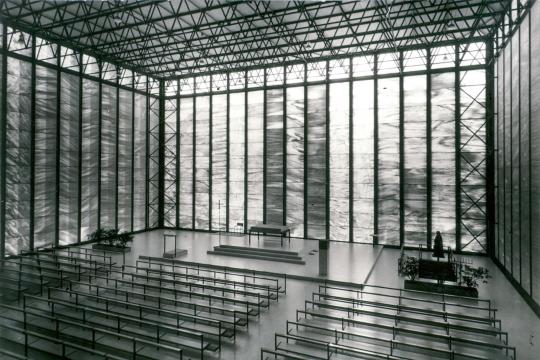
The 28mm thick Pantelikom marble from Athens filters the daylight and illuminates the space evenly. | Photo © Archives de la construction moderne (ACM), EPF Lausanne, from: Kunst + Architektur in der Schweiz, 2005, p. 57.
Diagonal wind bracings in the four corners stabilize the structure. The sloping topography of the site exposes a concrete base acting as a precise and sober volume for the lightweight church to sit on. The industrial use of steel as well as the project’s modularity bases on what Füeg had conceptually described as “start building a church as if it would be a factory.” [3]

The floor plan of the church and its repetitive grid. | Scanned from: Jürg Graser, Gefüllte Leere, Zürich 2014, p. 217.
The translucent marble panels shine outward during the night and light the hall subtly during daytime, creating a volume of light. The non-industrial trusses excluded, the constructive excellence, the rigorous execution of the details as well as the exposed structure are consciously derived from Mies’ idea of the symbiosis of architecture and construction.
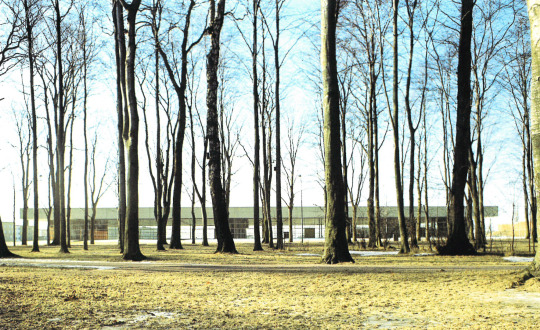
A weightless roof hovering above a glass volume. | Photo © Arne Jacobsen, Royal Academy of Fine Arts Library, collection architectural drawings, scanned from: Carsten Thau, Kjeld Vindum, Arne Jacobsen, Copenhagen 2001, p.454.
The Sports hall for the City of Landskrona (Sweden) by Arne Jabcobsen consists of a rectangular roof of 52x92 m, a podium elevated 20 cm over the ground and a transparent glass wall in-between. In order to remove every vertical sensation and reinforce the horizontal character, the columns are shifted to the inside of the hall and split in two.

The ball field and the bleachers as depression in the plinth. | © Dissing + Weitling’s archives, from: Carsten Thau, Kjeld Vindum, Arne Jacobsen, p.457.
In order to remove every vertical sensation and reinforce the horizontal character, the columns are shifted to the inside of the hall and split in two. The structure and the technical installations are hidden above a suspended ceiling, turning the roof into an abstract apparatus, breaking with Mies’ ideology of the structure as the main space defining element. The focus shifts from the construction to the volume. [4]
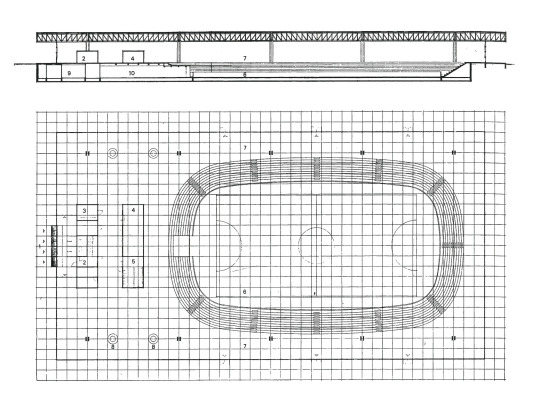
Like furniture elements, two wooden boxes stand inside the open space. | © Arne Jacobsen, from: Carsten Thau, Kjeld Vindum, Arne Jacobsen, p.454.
A ball field with its bleachers is sunk into the podium, two wooden pavilions house ancillary rooms. The wardrobes as well as the technical areas are inside the podium. While the architectural language and spatial organization still roots in the International Style, a new facet emerges as the expression shifts to “[…] a dematerialized architecture, an architecture without gravity. The dream of a hovering plane” as described by Thau and Vindum.[5]
The freestanding, multifunctional concrete oval bowl of the The Memorial Coliseum’s sports arena is wrapped in a 360-foot-square (109,72x109,72m) box. The four reinforced concrete columns are shifted into the inside and are totally independent from the arenas’ structure as well as the façade, offering a clear height of 10,97m.
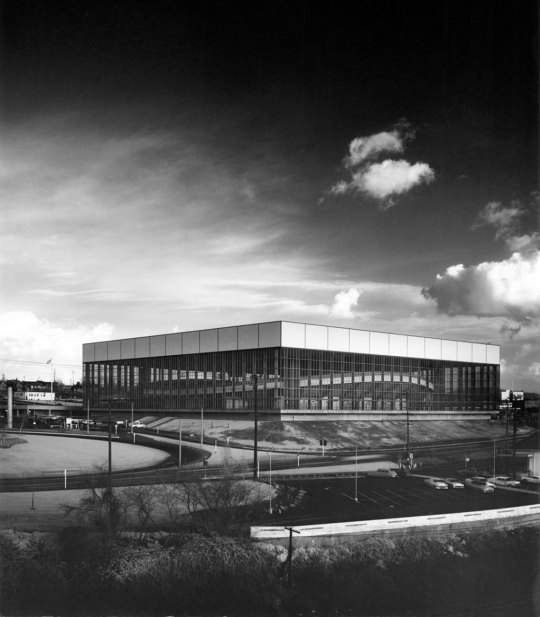
Filigree pavilion resting on an elevated plinth. | Photo © Julius Shulman, SOM
Cantilevered steel trusses are optimised in height and width according to the spans and hidden together with the technical ducts above a false ceiling following Jacobsen’s strategy of prioritising the space itself.

Circulation space between stadium and façade. | Photo © Art Hupy
While the spectators access the stadium from the parking lot through the glazed public area surrounding the oval, a plinth containing the restricted program is introduced.
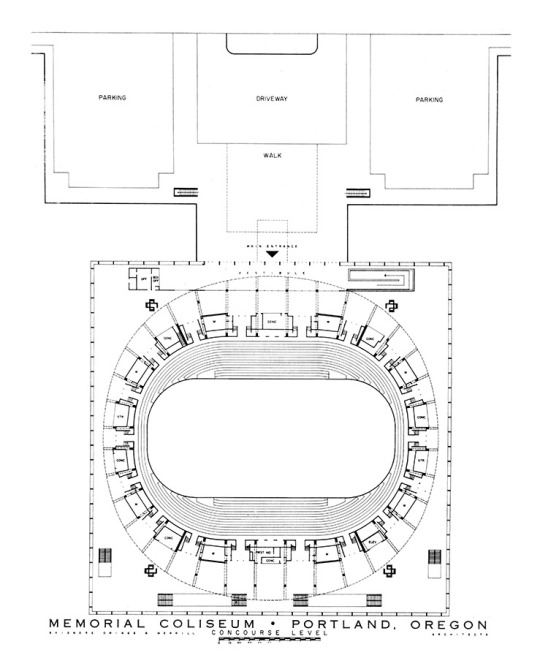
Access level of the spectators. | Plan © SOM
Being surrounded by a new artificial embankment, the glass pavilion appears to hover over the terrain. Staff and athletes access it through precise incisions in the ascending slope. The minimal architectural expression is characterized by the conceptual tour de force between the abstractness of the shell and its sculptural content.
---
FOMA 45: Guillermo Dürig

Guillermo Dürig is a swiss architect based in Zurich. He graduated from the Swiss Federal Institute of Technology in Zurich (ETH) obtaining his diploma in 2013. After interning at Juan Navarro Baldeweg in Madrid in the years 2009-10, Guillermo joined Jean-Pierre Dürig’s practice in 2013 and becoming the head of DÜRIG AG in 2021. The main interest of the office lies in the development of radical and conceptual projects, as well as in the execution of public buildings and large-scale infrastructures. In 2015 Guillermo co-organized the summer school ‘MAU’ in Motovun (Croatia). From 2016-19 he worked as a teaching assistant at the chair of Marc Angélil at the ETH, being in charge of organization of the semester on Madrid and Porto. Additionally, he has been a guest critic at the ETH as well as at the ZHAW. His works have been featured and exhibited in various specialized media.
_
Notes:
Mies van der Rohe, lecture, Chicago occasion and date unknown, quoted after: Fritz Neumeyer, Mies van der Rohe on the Building Art. The Artless Word, Cambridge 1991, p. 325.
Mies van der Rohe, undated typescript, probably prior to 11 November 1953, quoted after Phyllis Lambert, Mies van der Rohe in America, Montréal and New York 2001, p. 463.
Franz Füeg, Gedanken zum Kirchenbau, in: Bauen + Wohnen, 1958, 11, pp. 294-296. Quote translated by the author
On this shift see: Carsten Thau, Kjeld Vindum, Arne Jacobsen, Copenhagen 2001, p. 456.
Carsten Thau, Kjeld Vindum, Arne Jacobsen, p. 458.
Guillermo would like to thank Joshua Brägger and Philipp Krauer.
10 notes
·
View notes
Text
In a Parallel Universe
Could it be... fluff? The happy, uplifting tone of this can entirely be credited to Mustafa as a muse. I truly believe the man should be held up as an example of how to be a good human and how to be masculine without it becoming toxic. (The way he is treated by WWE, much like that other paragon of positive masculinity Sami Zayn, is something I can angrily rant about another time.)
Pairing: Mustafa Ali x reader (platonic)
Word count: 2,659
Content advisory: Racism/ racist language
“Did you ever have a thing for me?”
Your eyes widen in shock as you look back at Mustafa, your best friend, wondering if you’ve heard him correctly. He’s looking at you with those big, ingenuous eyes, as if he’s just asked you if you’ve decided what you want for dinner. In all the time you’ve known each other you’ve never once brought up the subject of romantic interest or physical attraction and yet here he is, just throwing it out there.
You’re watching your daughters collaborate on a colouring project that might as well be “Guernica” for how seriously they’re taking it.
The bell-like laughter of his wife and mother-in-law is drifting in from the back patio where they’re taking some much-needed time alone together.
You’re waiting on your husband Jake, who’s already sent four apologetic texts about how the Saturday he’s been called into work keeps dragging on, promising that he’ll be there as soon as he can, but that he doesn’t expect you to hold up the barbeque just for him. (Even though he knows you will.)
You laugh a little and squint at him, as if what he’s asked is somehow ridiculous. But it’s not ridiculous. Two heterosexual people who’ve been close friends for so long… it would almost be weird if there hadn’t been any sexual tension. Nevertheless, you think of just rolling your eyes and blowing the subject off. It would be easy enough to do. But his unwavering earnestness has always demanded respect and honesty and it’s possible that he knows the answer already. You certainly do.
“I guess,” you begin, aware that your voice is wavering a little, “early on. I had a bit of a crush.”
Is that the truth? In as much as feeling can be summed up in so few words, yes. It wasn’t like you’d been pining and crying yourself to sleep at night, but sure, you’d felt it. You’d approached him to ask if you could train with him after the two of you had worked a few of the same local shows where the wrestlers outnumbered the audience members. Yes, you’d been beyond impressed with his skills but you’d also noticed how very, very cute he was.
“I mean, everyone did,” you assure him. “All the girls liked you.”
Not all the girls had your confidence or your desire to really break in to the wrestling world, though. So you’d been the one to steel yourself and walk up to him at the gym one night and ask if he’d help you. It was a calculated risk, you figured: he could refuse, he could give it a shot and get bored or irritated and walk away, he could help you become a better wrestler even if he wasn’t interested in more, he could feel your skills were hopeless but also decide you were attractive enough to pursue, or he could want to be both a training partner and something more. Five possible outcomes, three of which worked in your favour. You’d always been clever with numbers and the numbers clearly gave you a better than even chance of a positive result.
He laughs shyly and looks down at the idea that “all the girls” had found him attractive. It’s not that he’s ever been insecure about his looks and charm, exactly, but he’s never been the sort of arrogant prick who’s assumed everyone must be in love or lust with him. And that’s always been part of his charm; confident enough not to seem needy but humble enough to appreciate the attention.
Of course, you’ve always been a little surprised that he doesn’t have more of an ego. The luscious mane of black hair, the smile that could power a small city, the toned body that never crossed into that lumpy, bulgy look that too many of your counterparts developed, and most of all those huge, soulful eyes… The man was infuriatingly flawless and even now it’s not like you are immune to the occasional whisper of desire.
“Shit. I never did anything to hurt you, did I?”
And then there was the personality. Mustafa had always been too great of a guy to be real. He’d been your rock. Whenever things ground you down, he was the one who could build you up again. When you got angry and depressed at the state of the world, he’d commiserate but he’d also be able to give you hope, if only because a world that produced someone as awesome as he was couldn’t be all bad.
You could honestly say that without him, you’d never have fought your way out of the indies and into the big leagues. That wasn’t just because training with him made you a stronger, better wrestler. It was because the two of you had been able to lean on each other when things were rough. And damn, things had been rough at times.
When the two of you had graduated from bar shows for disinterred old men drinking watered-down beer and playing slot machines, you’d been beyond excited. The shows you got invited to took place in gymnasiums and legion halls and church basements with actual audiences who had come specifically to watch the wrestling. You knew it wasn’t the big time; you were excited, not stupid. But it was progress and a lot of people you knew hadn’t even made it that far. You’d grounded yourselves by talking about your meager pay and by calculating how much you’d earned per bruise at each show.
One of the larger, or at least more successful promotions that had booked you had provided an eye-opening experience. The promoter was a corpulent man with a mouth full of lumps that barely counted as teeth and breath to match. He’d called both two of you aside a few hours before your first show to tell you the gimmick that he had in mind for the two of you. It had come as a bit of a surprise because although you were friends, you’d never teamed up in the ring. You’d reveled in being the foul-mouthed heel, while he had, of course, been a natural baby face. (And if you were honest, so few people knew who you were that your characters hadn’t ever mattered.)
“I wanna do a thing with the two of you,” the promoter began, sweat already dampening his forehead and staining the armpits of his cheap shirt. “You two are gonna be like a pair of terrorists. You can fight all the American guys- and girls- and get them over with the crowd. Get the audience riled up.”
The two of you had stared back at him in horror, jaws slack.
“I’m thinking something like ‘Osama and Elle Qaeda’ for your names.” His brow furrowed as he processed another idea. “Can you come up with some shit to yell in Arabic?”
You remembered thinking that it must be some kind of joke. Al Qaeda and Osama bin Laden were products of the Arabian Peninsula. Mustafa’s parents were Pakistani and Indian. Yours were Kurds from southern Turkey. Not one of your parents even spoke Arabic. But more to the point, the two of you were American. You were both born and bred in Chicago. Neither of you had any hint of an accent. Why couldn’t you just be normal?
The promoter looked at you impatiently. Mustafa recovered his voice enough to stammer through an explanation of your ethnicity, only to be greeted with a look of supreme indifference and boredom.
“Look,” he said sharply, “it doesn’t matter. You have the look. Around here you’re all sand ni-“
Remembering that night still hurts. The pain has dulled over time because at the moment he’d said it, it felt like you’d been shot in the chest. For a few moments you’d been afraid that you were actually going to vomit. Growing up in a racially mixed area, your features and your family name had been ambiguous enough that people thought that people usually guessed that you were Greek or Italian before they got to Turkish or even broadly Middle Eastern. You’d been proud to declare that you were descended from the little-known but courageous and resilient Kurds. But out here in the wider world, you were an Arab and therefore a terrorist. The Indian subcontinent, birthplace of so many cultures, arts, religions and philosophies, crossroads of empires, might as well have never existed. Mustafa was an Arab and therefore a terrorist.
Seeing what he perceived as hesitation, the promoter scowled at both of you. “Give it a shot,” he counseled. “It’s the only way people are gonna take you seriously.”
You and Mustafa smile at each other, as if you’ve both been recalling the painful judgments you’d faced together, as if you’re amazed you survived let alone flourished. You’d pulled each other through.
“I’d always kind of wondered if you’d ever liked me,” he says shyly.
Yes, you think, you had. You were a tall, muscular girl. It had made sense that you work with a male training partner. So he’d been happy to work with you and you were thrilled to be able to learn from him. You felt yourself improving every time you practiced together. But your mind had often drifted to how it would feel to have his arms wrapped around you in other circumstances. More than once you’d been tempted to close the scant distance between your lips just to see how he’d react.
“I liked you,” he adds, eyes snapping up to see your reaction.
You do your best to mask your shock. “You did?”
“Sure. C’mon, look at you.”
Your mouth feels a little dry. The sounds from the patio have faded and even the children have fallen silent.
“Maybe not right away because I thought you were kind of scary, to be honest,” he chuckles. “But after we’d been hanging around, I don’t know, about a year or so, I really liked you.”
You can’t help but laugh at the idea that you were scary. Maybe you’d thought you could be scary to some of the smaller, less experienced women you’d fought. But to someone on your level both skill-wise and vertically? No.
“I’m serious. I wasn’t desperate or anything but I remember thinking a lot about what might have happened if I’d made a move.”
You wonder about the math in your head. You hadn’t entertained those thoughts about him for all that long. Sure he was hot, but as you’d risen through the ranks together, he’d quickly come to seem like a brother. The idea of the two of you being a couple had started to seem weird. You’d thought about it less the longer you spent together, so it was strange for you to think that as you’d gotten over your initial crush, he’d begun thinking of you in that way.
Your shared reverie is interrupted as his little girl climbs into his lap, sour-faced and frustrated that she’s running out of brown crayons. The work of art that your girls are creating relies heavily on earth tones for the ground, for the tree trunks and bushes, and, you note happily, for the different faces of the people occupying the epic landscape they’ve made. There are all sorts of shades of people and there just aren’t enough brown crayons to build the different tones.
Your daughter purses her lips in a look of stubborn determination you’ve come to know all too well. She’s grabbed red crayons, orange crayons, yellow crayons, green crayons, whatever she can get her hands on to colour in her people. She’s as upset as her friend that there aren’t enough browns but she would never let on. As ridiculous as it seems, you’re actually a little intimidated by just how headstrong she is. Now that she’s learned the alphabet, she seems like she’s about ready to move out and start kicking ass.
She casts a quick glance in your direction and you have to hold back a gasp at her fierce, beautiful eyes. Looking at her face, you’re gob smacked by the idea that something that gorgeous came out of you. It’s like looking at the sun. It’s even stranger to think that she could be the product of the wild, all-encompassing lust that you and your husband had- still have- for each other. How could something that seemed so deliciously sinful produce something so perfect?
You glance back at Mustafa, whose attention is now completely absorbed in his daughter’s lecture on the need for more brown crayons. She’s articulate far beyond her years and you hope beyond hope that years of school won’t convince her to hide her intelligence the way girls of your generation did.
It’s possible that there was a time when your desire for Mustafa and his for you overlapped, that there was an opening when the two of you could have touched lips and fallen into each other as if nothing else in the world existed. The two of you would probably have been a power couple in the industry. Your dazzling combination of skills would have been irresistible. With the way your families have come to love the both of you, it’s likely they would have moved beyond the cultural differences that absolutely do exist, no matter what some ignorant arsehole might have told you when he insisted you were both Arab terrorists.
And it is most definitely possible that the two of you would be sitting in a living room just like this, embracing as you observed your children colouring or playing video games, or chasing each other around with rubber swords, or, worst of all, trying to emulate what they saw their parents doing on television. And perhaps as you watched, you’d look at each other and touch lips with all the tenderness in your souls and you would be filled to the point of bursting with happiness.
But then there would be no…
There would be no Jake, the man who made you realize what true, unadulterated love really was. You would never have had someone make you laugh the way that he can, make you laugh so much that your ribs ache for hours. There would never have been the man who taught you how to curse in Irish or how to snowboard. And you would not have your daughter, so filled with her father’s sarcasm and stubbornness.
For that matter, you would never have had Mustafa’s wife as your friend. When Jake had been hit by a car while riding his bike to work, you would not have had her comforting arms and her voice to pull you through the agonizing days when doctors cautioned you not to be too hopeful about his prognosis. You would never have had that feeling of someone strong enough to hold you up yet tender enough to nurture you through the pain.
A few hours later, the gang of you are gathered around the picnic-style table in the back yard. Mustafa, his wife, her parents, you, Jake, his brother who’s been run ragged by his job more than any of you, and, of course, your children. You’re all laughing so hard that it’s a legitimate danger that the neighbours will call the police with a noise complaint. You make a clever joke and Jake, impressed by your wit as he always is, presses a light kiss against your neck. You feel the familiar thrill move through you, suddenly thinking that it’s time to wind things down and head home. Just for a second, your eyes connect with Mustafa’s and there is this perfect, still moment when you can see that there could be an alternate universe where the two of you would be together, something that might have been better or worse or neither. But then the moment is passed, and you’re once again back in this universe with the lives that you love.
#wrestling fanfic#wrestling imagine#mustafa ali#mustafa ali imagine#wwe imagine#mustafa ali x reader#wayward wrestle writing
34 notes
·
View notes
Text
Trip to Bridgeport
In the second week of Chicago excursions I was assigned to explore the neighborhood of Bridgeport. Bridgeport is located in the city’s south side, the neighborhood is confined to the north by the south branch of the Chicago river stretching south to Pershing Road. Laterally the neighborhood spans from the Union Pacific Railroad tracks in the east, to Bubbly Creek in the west. Bridgeport possesses the title as the oldest neighborhood in the city of Chicago, officially becoming Bridgeport Township in 1863. The history of Bridgeport and what survives today projects different stories about the neighborhood. Originally an Irish enclave of industry, Bridgeport today is ethnically diverse with many varying socioeconomic levels residing in the neighborhood.

Map of Bridgeport
Industry began to boom in Bridgeport around 1830 when Stearns’ Quarry established a limestone quarry, dynamiting in the neighborhood until 1969 (Bloom, 2020). Industrialization swallowed the area, by 1905 the first privately owned and managed industrial park was established, called the Central Manufacturing District. The owners of the park invested into the neighborhood, building roads, public emergency services, a bank, and even leisure businesses. The demographic composed today in Bridgeport one will find around two of five residents being Asian, and one of five residents being of Hispanic dissent (Statistical Atlas, 2020). Immigrants from the old world flooded Bridgeport in aims for a working job. The Irish flooded the neighborhood first, soon to follow were northern and eastern European immigrants. Important to the neighborhood during the beginning of the 20th century was the railroad construction nearby (Bloom, 2020). Many of the workers who recently migrated were Mexican, who established homes in the neighborhood (Bloom, 2020). The remainder of the 20th century and leading to modern day, Bridgeport witnessed many Asian immigrants moving to the area. Being within close proximity to the city’s long-standing, well-established Chinatown district. Also residing near the historic district of Bronzeville, the population consists of African American and Hispanic dwellers.
What was once a booming sector of industry, today Bridgeport is now a cultural center for art and diversity. The neighborhood although slightly large on scale, is entitled to a strong sense of community. This strong sense of community may be one such production of the deeply rooted religious structures seen very visibly throughout the neighborhood. Apparent to the neighborhood is its nonsecular nature, with many ornate and magnificent churches. Also clearly apparent in Bridgeport, is the neighborhood’s lust for art, specifically modern, urban art; two art centers stand just a stone’s throw apart from one another. To note as well is the neighborhood repurposing efforts to transition areas of industry into public spaces. Many parks are scattered throughout Bridgeport today. On my visit to the neighborhood I was able to explore one of these parks, also I witnessed a few churches, and was able to tour the neighborhood’s art center.
During the Friday excursion of the neighborhood, I began my day at the Bridgeport Art Center. The art center is located on 35th Street, at 1200 West 35th Street, in the central manufacturing district; once the location for the Spiegel Catalog warehouse. Established in 2001, the Bridgeport Art Center is focused to continuously serve as a resource for creative minds, and to be the beacon for the innovating Chicago art scene (Bridgeport Art Center, 2020). The art center is home to numerous artists, designers, and working professionals. Incredibly, I was fortunate enough and one of the first to attend the art center on the same day of its 4th Floor Gallery opening reception. The gallery’s newest theme entitled ‘Where’s the Revolution,’ is an exhibition featuring political art expressing varying points of view of global politics and social justice standards (Bridgeport Art Center, 2020). The exhibits displayed depict themes current to modern issues in America. At the forefront of the exhibits were criticisms of the current presidency, as well as the extremely salient movement of Black Lives Matter. In one work the artist depicts the final words of George Floyd, “I can’t breathe.” The artistic piece utilizes yarn on canvas to depict the final words, in the artist’s own words, “lives holding by a thread.” Many of the artistic works also present an underlying theme of police brutality targeted against racial minorities.
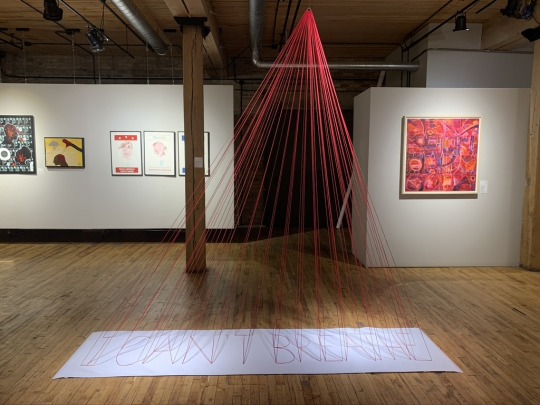
I Can’t Breathe by Pinar Aral

Floyd by Victoria Goite
Although the 4th Floor Gallery was fascinating to explore and witness, I was able to meet and discuss with internationally acclaimed Italian sculptor, Virginio Ferrari. During my walkthrough of the 4th Floor Gallery I was confronted by a waste management consultant who worked in the building. He thought it would be an advantageous opportunity to meet and have a dialogue with Ferrari. I agreed to his opportunity and he escorted me to Ferrari’s work space in the basement of the building.
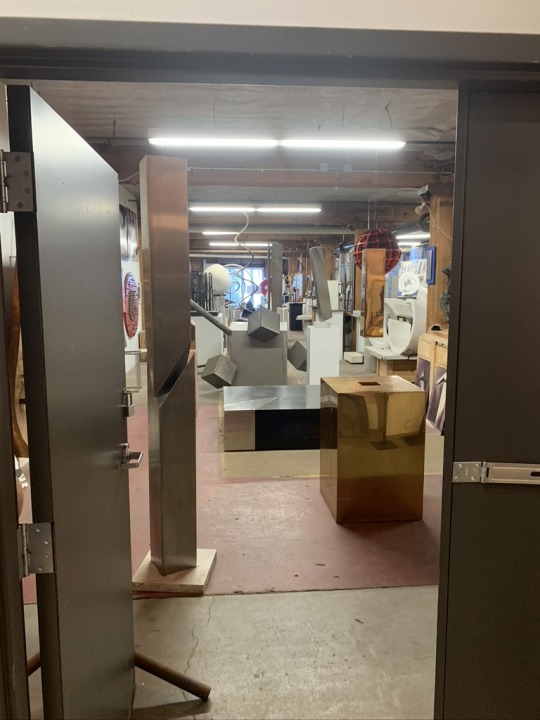
Virginio Ferrari’s Workshop in Bridgeport Art Center
I had the ability to have a personal tour of Ferrari’s shop by the man himself. He discussed his life story and beginnings of his artistic career. Mentored by his father and grandfather in the trade of stone cutting, Ferrari learned respect for the craft, and has continued his family’s legacy since. Ferrari is an immigrant of Italy who migrated to Chicago in the 1960s. After his migration to Chicago, Ferrari would serve for one decade as the Assistant Professor of Art and Sculptor in Residence, at the prestigious University of Chicago (Ferrari, 2020). Ferrari has thirty monumental pieces alone in Chicago, and other works can be witnessed all over the world, with sculptures located in Europe, Asia, and throughout the continental United States. Some of his most notable works found in Chicago include the Being Born exhibition near the Ohio Feeder Ramp in Riverside North, as well as the controversial exhibit Dialogo, which casts a shadow annually on May Day that depicts the Communist sickle and hammer (Ferrari, 2020). Even at the age of eighty-three year, Ferrari is still active with his craftsmanship, constantly creating new sculptures in his Bridgeport workspace.
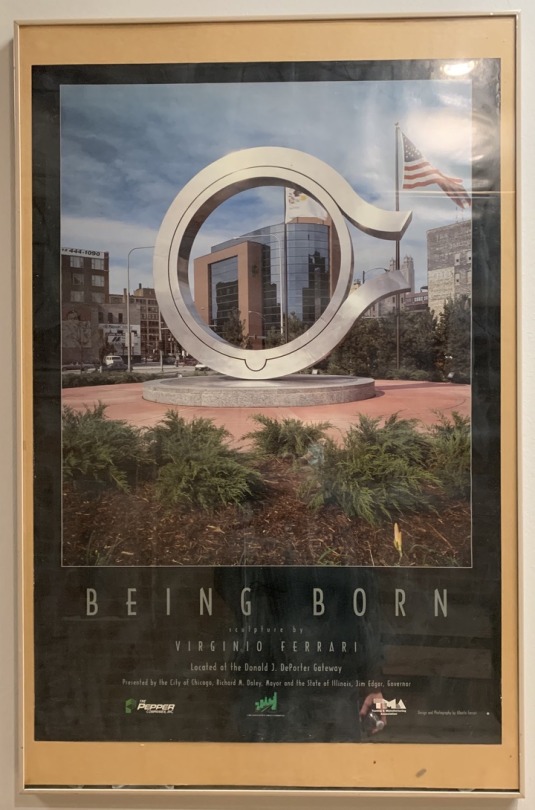
Being Born by Virginio Ferrari
Although the opportunity to meet the world renowned sculptor, Virginio Ferrari, was incredibly exciting, there was still more to see of the neighborhood. After my visit to the Bridgeport Art Center, I continued my morning walkthrough of Bridgeport by viewing a couple of churches located in near proximity. The first church I was able to visit was the Roman Catholic Church of St. Mary of Perpetual Help. This church has been standing in Bridgeport since 1882 (St. Mary of Perpetual Help Church, 2020). Its establishment was influenced by the growing Polish immigrant population in the area. It served as a community home for these Polish immigrants, and still serves today as the parish for the Catholic girl high school, De La Salle Institute. The building itself is magnificent with elaborate towers and a colossal dome, with intricate detailing found all over the building.
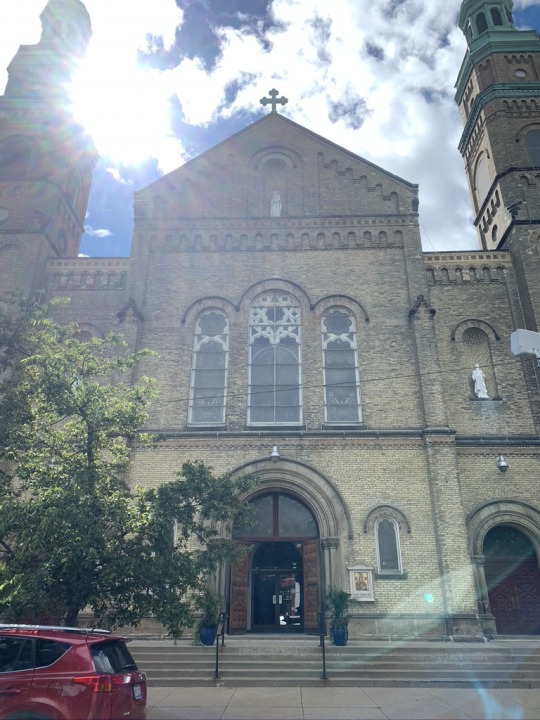
St. Mary of Perpetual Help Church, 1039 West 32nd Street
After my walk by the St. Mary Church, I was able to see the Monastery of the Holy Cross. This monastery was established a century later than the previous parish discussed, in 1988. Although the monastery was established in 1988, the building in which the monastery resides was once the home of a Polish parish, the Immaculate Conception Church (Monastery of the Holy Cross, 2020). The Monastery of the Holy Cross was founded by three missionary priests who sought out to combat the challenges of evangelization in the modern world (Monastery of the Holy Cross, 2020). The priest's mission was evangelization of the modern ‘desert’ of the city, which faces issues of violence, alienation, and spiritual poverty (Monastery of the Holy Cross, 2020). To comment on the building, the monastery is found at the location of the former Immaculate Conception church. The building although simple in design, with a only singular vertical turret attached, is known for its beauty. The sheer height of the tower was quite remarkable to witness in person.

Monastery of the Holy Cross, 3111 South Aberdeen Street
As the end of my trip neared, I decided to visit one of the local parks in the neighborhood. Located at 2700 South Halsted Street, in the heart of the Bridgeport neighborhood, I was able to visit the Palmisano Park and Quarry. Prior to the park, the area was most well known for the Stearns’ Quarry, in which massive amounts of limestone were extracted from the earth. This twenty-six acre site offers a bountiful amount of activities for visitors to enjoy. The park includes a fishing pond, interpretive wetlands, preserved quarry walls, trails, an athletic field, a running track, and over one and a half miles of walking trails (Chicago Park District, 2020). The park itself was gorgeous to walk around. It provided an incredible view of the Chicago skyline, and most notably preserves the land of the neighborhood. This park was very refreshing to experience. Being in the city can be overwhelming with the lack of green space, but the Palmisano Park adds a much needed escape from the urban environment. It is hard to imagine, but the natural landscape of Chicago is composed of a marsh, and this is made very apparent through the park. Tall grasses and a pond were just two obvious features of the park displaying marsh characteristics. It was a pleasant surprise to discover this park. Even though I have been living in the area for two years now, it was exciting to explore a new green space in close relation to my university.
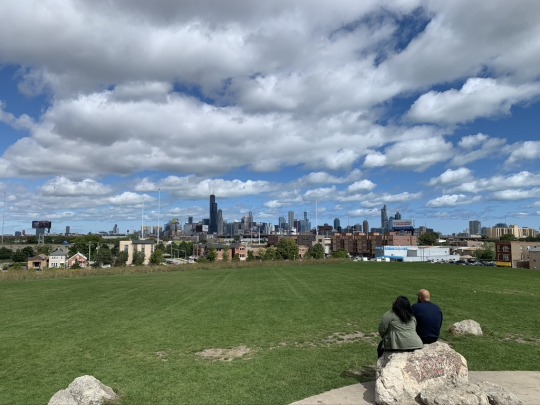
View of Chicago Skyline from Palmisano Park

Fishing Pond at Palmisano Park
Looking back on my trip to Bridgeport, the neighborhood is a multicultural enclave in a new emerging art scene. The oldest neighborhood of the city of Chicago surprised me with its numerous cultural identities. Initially founded by mainly Irish immigrants, the neighborhood has transformed its identity through the inclusion of other minorities. Immigrants from Mexico and Asia have built a new home for themselves in the neighborhood. The city in its past has been considered segregated, but this was not the impression I felt during my visit to the neighborhood. Bridgeport if anything, is a hub of acceptance and integration, consisting of many varying cultural and ethnic backgrounds. Made apparent by the religious institutions littered around the neighborhood, Bridgeport is a melting pot of culture, history, and art. Some individuals debate whether or not Bridgeport is the next ‘hipster’ neighborhood. I think that Bridgeport has the potential to grow to be this hipster hub. With two art centers already established in the neighborhood, along with a collection of unique restaurants, and public spaces for neighborhood residents to enjoy; Bridgeport, although the oldest neighborhood, is still transforming and staying up-to-date with cultural and social activities. I would recommend any visitor of Chicago to explore Bridgeport. As illustrated previously throughout this post, the neighborhood is compiled of varying commercial, religious, residential, and public spaces. Also home to the Chicago White Sox, the neighborhood offers plenty of activities for visitors to expierence. Bridgeport is a neighborhood of detailed and extensive history, but it is still transforming to serve the needs of its people.
Sources
Bloom, J. G. (2012). Images of America: Bridgeport. Retrieved September 25,2020, from https://www.google.com/books/edition/Bridgeport/JpjWCdLKyzEC?hl=en
Bridgeport Art Center. (2020). 4th Floor Gallery. Retrieved September 25, 2020, from https://bridgeportart.com/
Ferrari, M. G. (2020, September 02). Virginio Ferrari Foundation. Retrieved September 25, 2020, from https://virginioferrarifoundation.org/
St. Mary of Perpetual Help Church. (2020). History. Retrieved September 25, 2020, from http://www.stmaryofperpetualhelp.com/p/history-of-our-church.html
Monastery of the Holy Cross. (2020). Our History. Retrieved September 25, 2020, from https://chicagomonk.org/about-us/our-history/
Chicago Park District. (2020). Palmisano Park. Retrieved September 25, 2020, from https://www.chicagoparkdistrict.com/parks-facilities/palmisano-henry-park
Statistical Atlas. (2020). Race and Ethnicity in Bridgeport, Chicago, Illinois. Retrieved September 25, 2020 from https://statisticalatlas.com/neighborhood/Illinois/Chicago/Bridgeport/Race-and-Ethnicity
Photos
All of the photos illustrated throughout the blog were taken by me except for the following images:
Map of Bridgeport:
https://www.google.com/books/edition/Bridgeport/JpjWCdLKyzEC?hl=en
1 note
·
View note
Text










I haven’t felt this inspired by art in quite some time. David Schalliol’s work is breathtaking.
“The Isolated Building Studies are the visual confluence of my interests in urban dynamism, socioeconomic inequality and photography. By using uniform composition in photographs of Chicago buildings with no neighboring structures, I hope to draw attention to new ways of seeing the common impact of divergent investment processes on urban communities.
Isolated buildings are particularly useful for the exploration of neighborhood transformation and its social correlates because they are immediately recognized as unusual. As urban buildings, their form illustrates their connection with adjacent structures: vertical, boxy, an architecture confined by palpably limited parcels. When their neighboring buildings are missing, a tension emerges: the urban form clashes with the seemingly suburban, even rural setting. Thoughtfully engaging the landscape requires further investigation to resolve this tension: Why is this building isolated? It is from this fundamental friction that the Isolated Building Studies launches.
On one level, the details are helpful. In the case of older structures -- which are discernible by their brickwork, ornamentation and often the patina of neglect -- we see remnants of previous neighbors: an uneven side wall, an arch that terminates at its apex rather than at the ground, a fence dividing claimed and seemingly unclaimed territory. These physical aspects uniquely illustrate the history of the place as one of construction and, then, near destruction. The polarity is hindered by the survival of the subject building.
Yet the causes of isolation are not always chipping away at urban material to leave a monolith. In many cases, the built environment is razed and a new building -- typically identified by its pristine but unadorned façade -- is constructed on a site. Often located on the edge of neighborhoods suffering from decades of divestment, they are frequently harbingers of the aspirations of community change, if not the forerunners of the transformation, itself.
But the tension isn't only situated in the reading of landscape elements as old and new, in place and out of place. The underlying tension is that isolated buildings occupy a certain duality of transformation: with the dissolution of one community comes the creation of another. Whether a building is a pioneer or a survivor, built by gentrification or decayed by divestment, these buildings and their environs demonstrate how socially influenced investment cycles affect the visible aspects of our built environment, urban neighborhoods and community relationships.
Of course, the specific character of change and its message varies by type of building. Given their overwhelming dominance and importance, residential buildings comprise the core of the Studies. In many neighborhoods, particularly on the South Side and near West Side, these most personal places are the bellwethers of dramatic economic development dynamics. As our homes go, so go our neighborhoods.
Commercial and community structures are also featured in the Studies to signal the simultaneous connection and detachment these institutions have with residents in rapidly transforming neighborhoods. Given these buildings' roles as economic, spiritual and social loci of communities, their status is indicative of the health of those aspects of neighborhood life. When operating, such institutions are islands of stability for their constituents. When shuttered, commercial and community buildings demonstrate further ambiguity about transitions in neighborhood life. A church may just as easily close because of divestment as gentrification, given the corresponding changes in the characteristics of local residents.
These patterns can be clarified through the recontextualization of buildings from their given environments into an abstracted neighborhood of isolation by viewing the images as a series. In so doing, new construction and old, homes and businesses, rich neighborhoods and poor neighborhoods are placed side by side. We are thus pushed to investigate relationships, to delve into common histories and reveal the political and economic forces leading to isolation. This new method of seeing alters not only how we interpret what we perceive, but also which questions are raised. Instead of seeing one peculiar building, we see the legacy and immediacy of urban transformation. Instead of asking "What happened to this house?," we ask "What is causing this phenomenon?"
1 note
·
View note
Text
Lore Episode 17: Broken Fingernails (Transcript) - 12th October 2015
tw: death, corpses, misogyny (18th century-typical), infant death, hanging, being buried alive, ghosts
Disclaimer: This transcript is entirely non-profit and fan-made. All credit for this content goes to Aaron Mahnke, creator of Lore podcast. It is by a fan, for fans, and meant to make the content of the podcast more accessible to all. Also, there may be mistakes, despite rigorous re-reading on my part. Feel free to point them out, but please be nice!
For many cultures, the funeral is the last goodbye, it’s the final chance to say what needs said, or do what needs done, in order to honour the ones we’ve lost. But while the methods and purpose behind these rituals can vary drastically from one culture to the next, one thing is common among the vast majority: the burial. We bury our dead – we’ve done it for an incredibly long time, and we’ve gotten very good at it. Every year, archaeologists open new tombs that date back millennia, each one teaching us something new about the cultures that time has caused us to forget, and central to each of these discoveries is the burial itself - the techniques, the beliefs, the ritual. But it’s not just about the dead. The practice of honouring and burying our loved ones is just as much about our own feelings of loss and grief as it as about our responsibility to care for those who’ve passed away. No place personifies the act of burial more than the local cemetery. With their green lawns and neat rows of pale stones, graveyards are unique among urban constructions; they are respectfully avoided by some and obsessed over by others. But whatever beliefs you might hold, or opinions you might have about them, graveyards are a special place. Stephen King explored the allure and power of the graveyard in his novel Pet Semetary. In the story, the cemetery is a portal between our world and another, it’s a place of transformation, of transition, and of mystery, and while we might not be digging shallow graves for our pets in hopes that they’ll return to us in the night, we’ve never lost our fascination with those places. Cemeteries have always been seen as the end of the journey. Whether you believe in a heaven or not, the graveyard is where most of us will go when our time is up. For some, however, the story doesn’t always end there. Some things, it seems, can’t be buried. I’m Aaron Mahnke, and this is Lore.
For a very long time, burial in Europe was limited to church yards. It made sense - with a vast majority of Europeans holding to the Christian faith, all of them wanted to be buried close to their place of worship. But politics held sway even in these quiet, humble places of burial. Throughout Europe, it was common to find cemeteries that separated Protestant and Catholic graves. There’s a touching example of this near the Dutch town of Roermond, where a couple was buried in the late 1800s. The husband had been Protestant, while the wife had held to the Catholic faith. Despite strict rules regarding their burial, the couple managed to cheat the system by picking graves on opposite sides of the dividing wall. Their tall headstones reached above the wall and included carved hands that reached out to touch each other. Economic status played a part in burial as well – those wealthy enough could purchase space inside the church itself, while the less well-off had settle for graves outside the church walls, and even then, social status determined where in the yard a person might be buried. The higher the status, the closer to the chapel, but no one wanted to find themselves in the north corner. That was where people of uncertain birth, strangers from out of town and stillborn infants were buried. Regardless, churches filled up fast, as did the yards around them. As the population of Europe swelled, space began to disappear at an alarming rate. At first, graves were simply moved closer together, like the parking lot at your local mall – smaller spaces meant more occupants, and that was good for business, but it only worked for a while. Next, coffins were stacked one atop the next, opting for the vertical approach, but this meant that church yards were rising as earth was filled in between the growing graves, sometimes as high as 20ft. Greyfriars Cemetery in Edinburgh, Scotland is a horrific example of this problem. It used to be a depression in the ground, but overtime, it’s become more of a hill. With more than half a million recorded burials, the elevation has literally risen over 15ft, introducing problems that are unique to a graveyard so old and so full. According to reports, there’s such a high concentration of human remains that on especially rainy days, remains that aren’t sealed within a casket have a tendency to float to the surface, bursting through the mud like white teeth. All of this left cities in need of some seriously creative thinking.
In some places, the solution they chose was a drastic one. In France, for example, the government actually had to step in. Church yards had gotten so full that they would often collapse outward, spilling soil and human remains onto the streets. Walls were built around them; they rarely worked. The dead was getting out of hand, so to speak. In 1786, they removed all the bodies from Holy Innocence Cemetery in Paris and moved them to a series of unused stone quarries which became known as the Catacombs. It’s estimated that the Catacombs hold close to six million bodies. Sometimes it wasn’t a lack of space that ruined a cemetery, though, but a lack of popularity. That’s the fate that awaited the cemetery built on the former property of Sir William Ashurst in the north end of London. Named for the small, hilltop community that once existed there, Highgate Cemetery was established on the grounds of the old manor house, which had been demolished and replaced with a church in 1839. At first, the cemetery was popular: Karl Marx is buried there, as are many relatives of Charles Dickens and Dante Rosetti. But when the owners lost money and fell on hard times, the graveyard was left to the elements. Monuments and crypts became overgrown with vegetation, and sometimes trees would sprout up right through the graves themselves. Highgate is a wonderful example of what we all imagine a haunted cemetery might look like. Filmmakers and authors have been drawn to it for decades, tapping into its arresting visual atmosphere to create works of Gothic horror and fantasy. It was even the inspiration behind Neil Gaiman’s beautiful novel The Graveyard Book. But while there are plenty of stories about the history of graveyards throughout Europe and America, cemeteries have always been known for something darker, something less tangible than what we can see above ground. Perhaps it’s all those neat rows of bone-white headstones, or the notion that hundreds of bodies lay waiting beneath our feet. Whatever the reason, its in the local graveyard, more than any other place, that we find rumours of the otherworldly and unexplainable. Inside those walls, between the pale stones and dark trees, almost everyone has heard tales of those who refuse to stay in the grave. Buried or not, sometimes the past is too traumatic to leave us.
Just south of Chicago, between the curving arms of I-80 and I-294, is a graveyard known for a level of activity unusual in a place of the dead. Bachelor’s Grove Cemetery isn’t big – there are only 82 plots there and many of those have never been used, but that hasn’t stopped the stories. It’s said that the famous gangster Al Capone once used the pond nearby as a dumping place for the bodies of those he killed. Other rumours make reference to Satanic rituals and meetings that have taken place in the graveyard over the years. But there are those who swear they have seen unusual things there. The most famous sighting has been called “The White Lady”, the ghostly image of a woman that was said to appear only during the full moon. In 1991, the Sun-Times actually featured a photo of the White Lady on the front cover, taken by a researcher on one of her visits. The woman appears to be semi-transparent, sitting on a tombstone near the trees, and dressed in white. Other visitors have seen glowing orbs and apparitions, and even vehicles and a farmhouse that seem to fade in and out of existence. The site is off-limit to visitors now, but it’s remained a favourite haunt (no pun intended) of ghost hunters across the country. In 1863, an outbreak of smallpox moved through a Civil War POW camp in Columbus, Ohio. The camp held close to 10,000 confederate soldiers, and thousands of them died from the epidemic. As a result, the Camp Chase Confederate Cemetery was formed, an unusual sight so far north into Union territory. Miles away, in New Madrid, Missouri, a Confederate sympathiser sent his young daughter north to avoid the destruction of the war. Louisiana Briggs settled into Ohio and eventually married a Union veteran, but she apparently never lost touch with her southern roots. It was said that later in life, she would often visit the Camp Chase Cemetery, where she would place flowers on various graves there. She wore a white veil each time she went, in an effort to hide her face. Nevertheless, she acquired a reputation around town as the “Grey Lady” and was known for her passion for the old burial ground. She passed away in 1950, but flowers would still appear regularly on the graves there. Visitors to Camp Chase have heard the sounds of a woman weeping quietly, while others have seen the figure of a woman in a veil. Something drew Louisiana Briggs to that location, that much is clear. According to the stories, though, she never left.
Across the country in Connecticut, yet another graveyard plays host to a mysterious story. Mary Hart was born in New Haven in 1824, and lived a very modest life there. She was a corset maker and machine stitcher by trade, working hard to support her family. On October 15th, 1872, Mary fell into a death-like state from unknown causes. She was only 47, young even for the late 19th century, and this tragedy rocked her family to the core. By midnight, Mary had expired, and her grieving family set about to arrange for a quick and immediate burial. There was a lot of pain, I can imagine, and they simply wanted to move on. It’s said that Mary’s spirit still wonders Evergreen Cemetery, close to the site of her home on Winthrop Avenue. More than one story has been told about drivers pulling over to pick up a hitchhiking woman, only to have her disappear. Others say Mary was a witch, although you didn’t have to look far in the late 1800s to find a woman who had been accused of something like that. According to the stories, local college students have frequently visited Mary’s grave, which is said to be cursed. Anyone who visits her grave at midnight, according to legend, will meet a horrible fate. As a result, most people refer to her today as “Midnight Mary”. There are no records of New Haven college students who’ve died after visiting Mary’s gravesite, but whether or not the stories are rooted in fact, it hasn’t stopped them from spreading. Mary still has one foot in our world, it seems. It’s just not clear who’s keeping her here.
South Cemetery in Portsmouth, New Hampshire is really a collection of many smaller graveyards. It’s the site of the oldest burial ground in town, dating back to the 1600s, and it’s a wonderful mixture of styles and centuries. Together, the Auburn Cemetery, the Proprietors’ Burial Ground, Sagamore Cemetery and Harmony Hill all combine to showcase everything from an Egyptian-style sarcophagus, to winged skulls and Victorian funerary imagery. It’s a peaceful place, and much of the grounds have been planted with flowering trees, creating a park-like atmosphere, but that wasn’t always the case. In the 1700s, South Cemetery served double duty as both a graveyard, and the site of several public executions. All of them were hangings, and more than a few of them were women, and the reasons were often tragic. The early 18th century was a very different era from our own, and the lawbooks were filled with rules that might seem barbaric or cruel by today’s standards. Provincial laws at the time required capital punishment for a wide assortment of crimes – close to 600 of them, in fact, including murder, rape, abortion, bestiality, burglary, treason and counterfeiting. Another capital crime, though, was known as “concealment”. If a woman found herself pregnant outside of marriage in the mid-1700s, her life was effectively over. Social stigma, loss of employment, fines and even physical punishment were all expected to follow upon discovery of adultery, and the possible resulting bastard birth. And so, to avoid this fate, it had become common for women in that situation to hide their pregnancy, and then abandon the baby to die of neglect and exposure. This was concealment, and it was the situation that a woman from South Hampton, New Hampshire found herself in, in the spring of 1768.
Ruth Blay was just 25 and split her time between teaching in the nearby towns and working as a seamstress. She was single and poor, but she did her best to hide the pregnancy for as long as she could. No one knows when she gave birth to the child. We don’t know if she laboured alone, with no hand to hold or companion to help her through it. All history remembers is the baby, but even then, there are still questions. According to Ruth, the baby had been stillborn. That didn’t erase her crime of adultery, of course, or the stigma that was sure to follow, but it did mean that she didn’t kill the child. She had been afraid, and so she buried the tiny body beneath the floorboards of a local barn, most likely the site of one of her travelling classrooms. And that, she thought, was the end of it. But what Ruth didn’t know was that some of her local students had watched her – they didn’t see the birth itself, they didn’t feel her pain, loss, fear and hopelessness. All they saw was a young woman placing a body in the small space beneath a loose board. They saw a crime, and so the reported it. Ruth was soon arrested by Isaac Brown, the local constable, and was quickly brought to trial. A jury of 16 was formed, all men, of course, and they soon ruled that the child had died by violent birth. Ruth, they said, was a liar and a murderer. Ruth was held at the constable’s home until she could be transported to the jail in Portsmouth, but she was still recovering from the birth, and so she remained there for over a month while her body healed. By July 19th, she had formerly been accused, and two weeks later she was brought before the provincial court. She pleaded innocent, of course, but no one listened. Her final trial date was set for nearly two months later, for the end of September. I can’t imagine how lonely she must have felt, how hopeless. Ruth didn’t have a chance. I think it’s safe to assume she knew that – society wasn’t kind to women in her position, and when you added in the dead infant, well… Ruth was pretty sure how it was going to end. The trial began on the afternoon of September 21st, 1768, and a little over 12 hours later, a 12-man jury handed down the verdict: guilty. She was, according to their instructions, to hang by her neck until dead. But not just yet. No, the royal governor of New Hampshire, a man named John Wentworth, issued three consecutive reprieves, postponing her execution. He said it was to give her time to prepare herself for death, but I can’t help but wonder if it was really just one more punishment. Rather than walking to the gallows before the end of September, Ruth would have to wait three long months. Just before noon, on December 30th, over 1000 people gathered at Gallows Hill in South Cemetery. It had snowed earlier that day, and now a cold, freezing rain was covering everything in a layer of ice. Sheriff Packer, the man presiding over the execution, had Ruth placed atop the back of a wagon, a rope draped over her head. Parents stood with their arms around their children – children who craned their necks to catch a glimpse of the woman about to die. There are rumours that a pardon was on its way from the governor, that Sheriff Packer was in a hurry to eat his lunch, and so he rushed the execution rather than waiting for the governor’s letter to arrive. At noon, the horses pulling the wagon were driven away from the tree, and Ruth Blay fell off the back, where her body swung slowly at the end of a noose. She died moments later. Those same rumours say the governor’s stay of execution did arrive, just moments after Ruth’s body stopped moving, but there’s no record of a pardon. Instead of freedom, Ruth was given an unmarked grave, about 300ft north of the small pond in the middle of the cemetery. Today, visitors to the pond report anomalies in their photographs – ghostly images, orbs and indefinable shapes. Some say that their cameras stop working altogether when there. According to local legend, a pair of glowing lights has been seen there, and some think its Ruth and her infant child.
Between life and death, between the places most familiar to us and that vast expanse of the unknown, sits the graveyard. It has represented the beginning of a journey for countless cultures across the history of mankind. From the Egyptians to the Khans, from ancient Europe to modern America, the cemetery is a constant thread, tying us all together. All philosophy aside, these are places born out of loss and filled with deep emotion. And so, it’s no wonder that so many stories exist of the ones who refuse to stay buried. Maybe ghosts are real after all, or maybe we just wish they were, or perhaps it’s both. One final note: Midnight Mary, the New Haven corset maker who fell into a coma at the age of 47, was buried the following day, on October 16th, 1872. That night, after the funeral was over and her extended family had travelled back to their homes, Mary’s aunt had a horrible nightmare. In her dream, she saw Mary still alive in her coffin, scratching at the lining in an effort to get out. She was screaming and moaning with desperation, and the image of that stayed with Mary’s aunt long after she awoke - so much so that she managed to convince both her family and the authorities to exhume Mary’s grave. After the coffin was removed from the earth, the men opened it. What they found inside would haunt them for the rest of their lives. Mary’s corpse had moved. Her hands were covered in blood, and many of her fingernails were broken. The reason was clear after examining the coffin’s lid: the cloth lining had been shredded. Apparently, Mary had finally awoken from her coma, and in her panic, she had tried to claw her way out.
This episode of Lore was produced by me, Aaron Mahnke. You can learn more about me, this show, episode transcripts, Patreon member benefits and more over at lorepodcast.com, and be sure to follow along on Twitter, Facebook and Instagram, @lorepodcast. This episode of Lore was made possible by you, [Insert ad break]. And as always, thanks for listening.
#lore podcast#podcasts#aaron mahnke#midnight mary#louisiana briggs#bachelor's grove cemetery#camp chase cemetery#highfate cemetery#hauntings#new hampshire#illinois#ohio#transcripts#17
2 notes
·
View notes
Text
yesterday was the 10th anniversary of my grandfather’s death.
the last part of the Bad Shit Trifecta from 2008
it went like this:
I was in a village in Ecuador (in Peace Corps). The week before, i had gotten email from Mom to see if maybe I wanted to come home for Christmas because my grandpa wasn’t doing great.
Wednesday, I was getting ready to do laundry (by hand, ugh), when my cell phone rang--and the caller ID had my mom’s actual cell phone number, which meant this call was costing a lot of fucking money, which meant something was wrong. She told me my grandpa (her dad) had died.
I asked if I could come home. She said they’d make that happen.
The next morning, I took a 6 hour bus ride to Quito. The following day I flew to Chicago, met my parents, and we drove partway to Kansas. Saturday night we were at my aunt and uncle’s house and I was borrowing their washing machine because all I had in my bag was dirty clothes.
It had already been a rough year, I got yanked across continents from my quiet house in a quiet mountain village and into the chaos of my mom’s giant extended family without much warning, and I was just... numb.
My grandpa spent 5 years building schools and fixing trucks, the last years of the Belgian Congo, before Independence. He was a kid during the Dust Bowl and any time it rained he’d say “Isn’t that a beautiful sound?” He told my mom she couldn’t study art because she’d never make a living. He made my grandma take Solitaire off the computer because card games are Bad. None of my uncles like tomatoes because he had a greenhouse and made them work pruning the vines. He had an ancient Ford tractor that he’d take us out in when we were little, sitting on his lap and steering. He took me and my sister out for ice cream one summer, to a place with a tall wooden counter and homemade waffle cones and we got to eat ice cream before supper.
I never got to tell him about near-vertical wheat fields, as different from western Kansas as you can get. Didn’t get to see him shake his head at the way they’d disc the fields top to bottom, dust billowing up behind the rented tractor. Didn’t get to show him the little greenhouse I built, from PVC pipes and wire and plastic, the tomatoes I grew there, a few hundred miles from the equator and nine thousand feet above sea level.
I never had to tell him I’m queer.
He’s the smell of wheat chaff and machine oil, sweat and dry soil. Bow ties for church, well-worn caps from Co-Op Grain and Supply out in the yard. Morning devotions, his Bible and the little book by his place at the table.
The rhythm of rain on the roof. Isn’t that just a beautiful sound?
9 notes
·
View notes
Text
Solo Trip to Bogota
Nervous about my first international solo trip, I landed at the El Dorado International Airport and worked up the courage to use my very limited and very broken Spanish to acquire a SIM card, exchange some cash, and grab a taxi to head to my hostel. I gave the driver the address to the hostel, which he did not recognize, and after telling him it was in the La Candelaria neighborhood and setting my google maps GPS to direct us to the hostel, I let out a sigh of relief. While he was driving me to my hostel and occasionally getting lost, I directed him by telling him “derecha aqui”, “izquierda a la calle once”, etc. With 15 minutes remaining on our drive to the hostel, I looked down at my phone to the terrifying realization that my phone only had 9% battery remaining. I thought to myself, “if my phone battery dies now, I have no way of knowing where to go, and neither does my driver”. Luckily, I made it to my hostel with 3% battery remaining, and again, I let out an even deeper sign of relief.
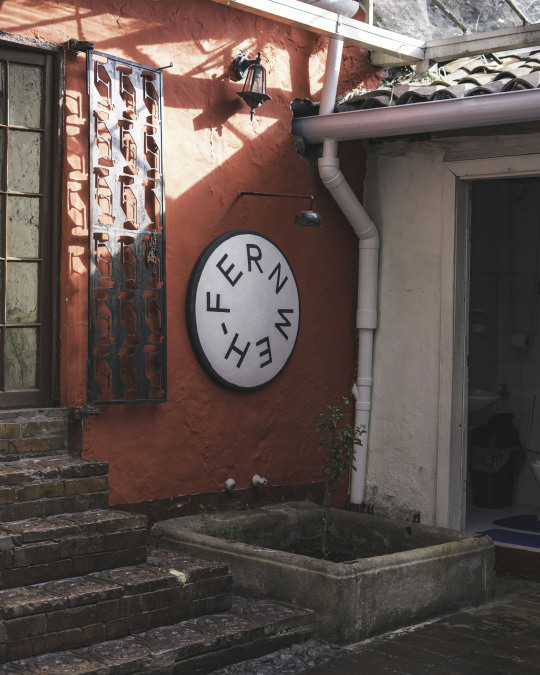
I put my belongings down in my aesthetic and quaint hostel, plugged in my phone, and let my mind rest. As I was hanging out on the hammock in the shared space, figuring out my plan for the rest of the evening, two guys arrived at the hostel named Colin and Luke. Talking to Colin for a bit, I learned that he was a coffee roaster for a small company based out of Chicago.

I started to wander toward the Botero Museum, but got distracted by the large crowds down the street. I wandered past artists selling their handmade jewelry and handwoven bags and into a wide open square covered in pigeons. Looking at google maps, I realized I had wandered into Simon Bolivar Square - a popular tourist destination. I sat in the middle of the square and watched as vendors went around trying to sell jewelry, selfie sticks, fruit, and corn kernels - used to feed the pigeons in the square. I scanned the square and laughed as tourists tried to stay still and pose for a picture as pigeons flocked to their corn kernel-filled hands.

After being approached many times by vendors and being satisfied with the photos I captured in the square, I made my way back up the street to the Botero Museum. Fernando Botero is a famous Colombian artist, made known for his unique painting style of chubby subjects. In addition to artwork from Botero, the museum was also scattered with paintings of Picasso, Monet, and Degas.
The Museum was closing soon so I decided to head back toward the hostel to find a place to eat. I stumbled in on a restaurant called “De Una Travel Bar” and used my best Spanish to order myself a meal and two local Colombian beers. Satisfied with my first meal in Colombia, I made my way back to the hostel, hoping to meet and spend time with some of my hostel mates.
Oscar, who was originally from Sydney, Australia was already hanging out on a hammock in the common room and he was quick to start up a conversation with me. Soon after, Shaun and Emily, a couple from Perth, Australia joined us in the shared space. Emily was originally from the states but recently moved to Perth to be with Shaun. Later, Marcel joined us.
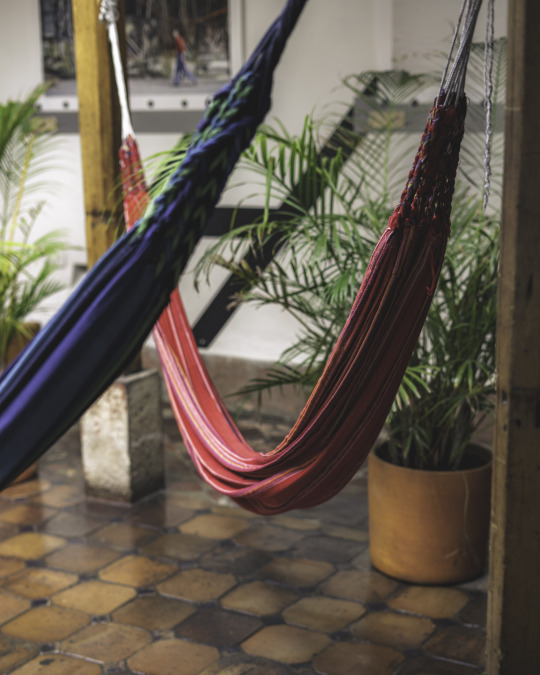
We went around the table and answered the following questions: How long have you been traveling, how long are you in Colombia, where have you been and where are you going? Most of the people around the table had some wild travel stories, and had been on the road for quite some time. I was the odd one out, admitting that I was only in town for the weekend.
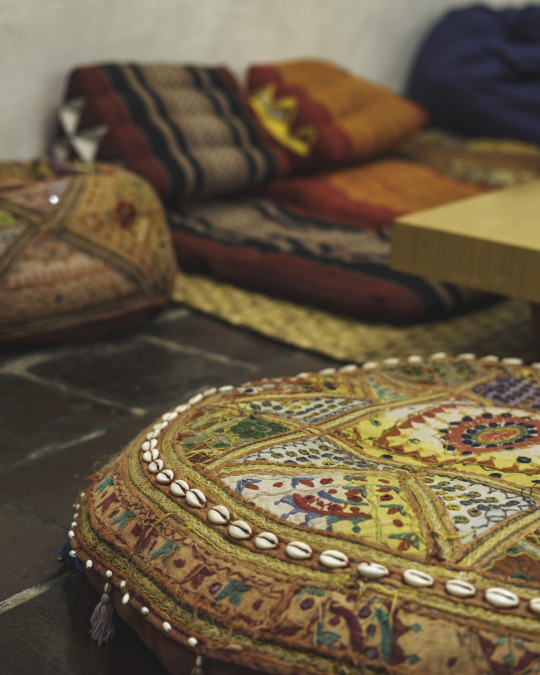
We quickly exhausted the conversation about the logistics of each of our travel plans, and began talking about the different places we call home. I was most curious about Emily and Shaun’s story, of how Emily who grew up in the United States learned to live in Australia, whose seasons are opposite to what she was used to. Curious about what mysteries lie on the opposite side of the planet, I eagerly listened to the stories that Emily, Shaun and Oscar had to share about Australia.
Soon it was getting dark so we made plans to go to a nice coffee shop in the morning and went to bed.
I’m not sure if it was the sun or the sound of cars driving by on the cobblestone roads just outside of the window that woke me up in the morning. Coffee is one of my big passions so I sprang out of bed, excited to get going to this nice coffee shop other hostel mates were buzzing about. We gathered our crew and walked to the highly aesthetic coffee shop down the street.

Luckily, this cafe had a cupping (coffee tasting) option where they brought out three different coffees in little taster cups. In addition to the coffee, we also each ordered avocado toast. As the food came to our table, we were blown away at how beautiful and delicious the breakfast looked and joked about how much this delicious breakfast would have cost in our respective countries.
Marcel, David and I planned to do the “Bogota Graffiti Tour”, a local walking tour that took us around the streets of Bogota so we could learn about the graffiti of the region, the history of the artist, and the political and social message behind the artwork. As a solo female traveler, I was nervous about venturing too far from the comforts and safety of the tourist areas, but this tour was a great way for me to comfortably explore more of the city of Bogota without risking my safety.

Our tour guide was very informed about the graffiti in the city, as he was a graffiti artist himself. He explained that many of the pieces in the city were politically motivated and made me appreciate the power of art in cultural and social movements. In addition to having the opportunity to learn about the public artwork, I was also glad to have the opportunity to witness the daily lives of the local people.
Unlike any North American city I have ever been in, I felt as though each of the neighborhoods in Bogota were wearing the emotions of the people that resided in them. In the urban, residential, and economically unstable areas where the effect of the government is palpable, the political and social frustrations of the people manifested in powerful murals that could be found along every main street. In the La Candelaria neighborhood, home to tourism and the international youths, the walls were vibrant, fun and whimsical. The political messages did not adorn the walls of this neighborhood as to not upset or confuse the guests. In the business district of the city, the walls resembled that of a North American metropolitan center - plain, simple as if trying to keep up with other technologically advanced cities.

After two hours of walking around the city of Bogota in the heat of the day, we returned to the La Candelaria neighborhood and found a restaurant with local food. We all ordered the meal of the day, which was a humble coriander soup, rice, salad and a single fried plantain. It was exactly what I needed before returning to the hostel to recharge for the remainder of the day.
I took an hour to recharge - both myself and my phone, and soon after ventured out on the streets of La Candelaria on my own, exploring the architectural details of this colorful town. The lights and shadows of the day played well on the brightly painted walls and the warm sun and Latin American humidity was a treat for my dry and weathered skin.

The sun was beginning to set so I took toward Cerro Monserrate - the mountain that towers over the city of Bogota. I was told that the view from this mountain top would put into perspective the size of the Latin American metropolis. There are three ways to reach the summit - a 2,000 ft vertical hike up the side of the mountain, a cable car (which was currently undergoing repairs), and a funicular - a train like vehicle that slowly trails up the side of the mountain. I didn’t have the proper attire for a hike so I opted out of the active option, which left me with a ride up the funicular. As we climbed to the top of the mountain, I started to grasp the size of the city of Bogota.
Latin America is heavily influenced by the Catholic Church and the city of Bogota is no different. At the top of Monserrate Mountain was a giant Catholic Church that was built to honor God in the highest and most visible place in the city. Looking across to the neighboring mountain, there was a gigantic status of Jesus Christ much like the famous “Christ the Redeemer” statue in Rio de Janeiro, Brazil though this one was not available to the public.
I was expecting to meet up with David, Marcel, and Bella at sunset so I killed some time by venturing around the tourist market while I waited. Time after time I turned down the vendors trying to convince me to buy their souvenir trinkets.
About half an hour before sunset, David arrived and together we looked out on the city in silence. Having just met and both of us being relatively introverted, we didn’t have much to talk about. It brought me joy to look around and see all kinds of people and groups enjoying the sunset on this particular evening. Next to us was a very intimate and well-dressed couple, and if I had to guess, this was one of many romantic stops for the evening. Families with crying babies huddled together s the temperature began to drop. International groups of high schoolers couldn’t contain their excitement to be in a foreign country with their 25 “closest” classmates. And then there was David and me, silently appreciating each other’s company without necessarily needing to fill it with words.
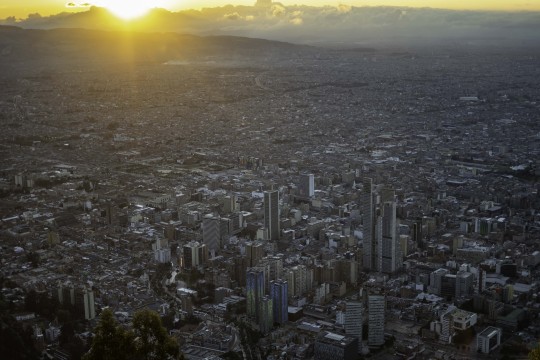
A couple minutes before the sun tipped below the mountains in the distance, Bella showed up with her signature bubbly personality and Marcel quietly tagged along behind her. We enjoyed the final moments of the daylight and as the temperature quickly dropped, we started back toward the funicular and down the mountainside.
We went to a restaurant near the hostel called Gato Gris, another recommendation from a fellow traveler. It was a nicer, more expensive restaurant, but it was my last night in Bogota so I decided to let myself splurge. We were seated in a tiny room in the upstairs corner of the restaurant and I admired the decor in this space. The first thing I realized was that an old door had been fashioned into a dining table, and the space was dimly lit with a uniquely boho light fixture.

As we sat around the table waiting to order, I was surprised at how much our time together was dominated by silence. As a group of travelers with a royal collection of unique experiences, I was expecting our time together to be filled with conversation, jumping in and out of stories and never finding enough time to tell the best stories from each of our travels. Instead, our group tended toward silence, over dinner, while waiting in line to buy tickets for the next tourist attraction, and this uncanny silence took me by surprise.
I woke up bright and early in anticipation for my last day in Colombia. Looking around at the other bunks in my room, it was only me and one other person in the sleeping quarters, and everyone else had continued on with their travels. I was on my own for my last half day in Bogota so I decided to go and explore as many coffee shops as I could. Unfortunately, it was Sunday which meant that most of the cafes were closed, but I had a plan to visit two different ones.
I returned to the cafe we went to the day before - Azahar cafe and in my best Spanish, I ordered another cupping plate, but asked for different coffees from the ones I had the day before. The barista seemed to understand my request and brought me different flavors from the ones I had the previous day. I enjoyed the avocado toast from the day before so I decided to order that as well. After filling up on breakfast, I bought a bag of coffee beans to bring home and went on my way.
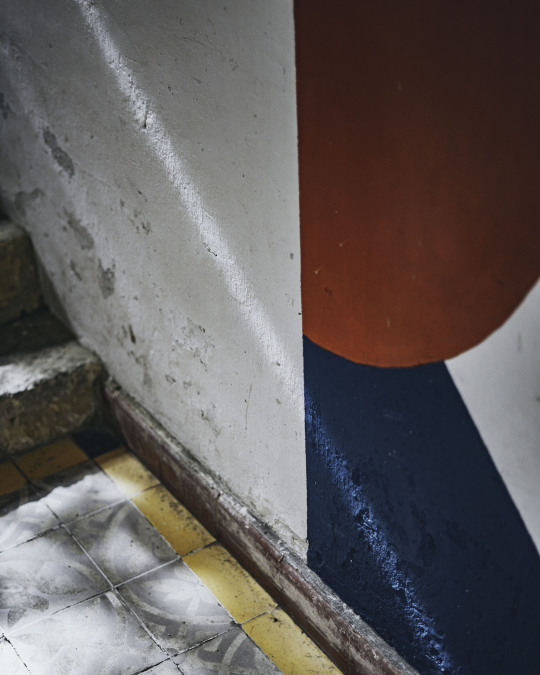
I stopped in at the Simon Bolivar square again to see it in a different scenery. Since it was Sunday, there was an ongoing Catholic mass that I got to sit in on for a couple minutes. Though many elements of my faith align with that of the Catholic church, the liturgy and catholic priests performing ceremonial acts made me feel very far from God.
I only had a couple hours remaining so I began to wander over to the next coffee shop. I located the coffee shop on google maps but was unable to find the storefront anywhere. Again in my best Spanish, I asked the security guard of the library if they had any idea where this coffee shop was. In very fast Spanish and some vague hand motions, they directed me into the library, through the hallway and around several corners. After asking several other guards inside the building, I eventually found my way to the very kind cash register who made me a fresh cup of coffee and helped me pick out two more bags of beans to bring home.

I sat on the couch in the silent library hallway, sipping on my coffee when a stranger joined me and began to talk in very fast Spanish while pointing at my camera. I regretfully told him that I didn’t speak Spanish “lo siento, no hablo Espanol” and he lit up and responded in very good English “Oh, do you speak English”?
He told me that he was planning on buying a camera but wasn’t sure what kind he wanted. I walked him through different types of cameras, the different models available, but after a short while, I realized that this all seemed to be going over his head, and I wasn’t sure if that was because of the language barrier or the content of our conversation.
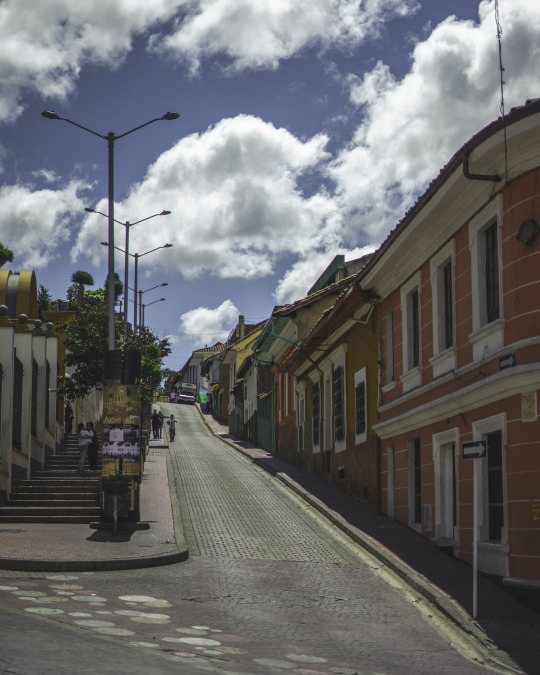
It was time to head back home, and a part of me was glad. I felt like my mind was being pulled in so many directions and I had so much to think about.
On the flight home I had a lot to think about. As my first international solo trip, I carried with me excitement, and fear, and had a mind full of doubts. Being able to explore Bogota with the company of other foreign travelers, I felt much more at ease about my own safety, but felt like sticking to my comfortable, English-speaking bubble limited me from truly experiencing all that Bogota had to offer. Spending time with these carefree, fearless travelers unexpectedly stirred up emotions about a topic I feel so passionately about - the purpose and intention of travel. I once envied the boldness and bravery of people who choose to put their lives on hold to travel the world for several months, but after spending time with these people, I was confronted with the reality of this glamorized life choice.
I still have much to process about my reasons for traveling, and hope to one day be able to develop cohesive thoughts about the value of modern day travel.
1 note
·
View note
Text
Facts About LU/LA Elevators in Dekalb and Chicago, IL
Property builders are concerned about providing accessibility options. Climbing the stairs painstakingly to reach the third or fourth floor is impossible for the users. Almost all developers decide in favor of installing a quality elevator. However, many commercial buildings that cater to specific demographics of the society feel the need for something extra. Ensuring proper accessibility for seniors and disabled persons can be achieved by deciding to install LU/LA elevators in DeKalb and Chicago, IL.
The United States of America has set standards for seniors and people with mobility issues. Buildings used by such individuals have to be compliant with the Americans with Disabilities Act (ADA). The LU/LA elevator is included in the list of accessibility features more often than not. This makes it essential to learn about what the term means.
Well, it suffices to know that LU/LA is an acronym for Limited Use/Limited Application. Such elevators are a hybrid between a traditional commercial elevator and a wheelchair lift. Sure, the appearance and functions do not differ greatly from the standard elevators, but the primary function of the LU/LA elevator is to help the mobility-challenged individual perfectly.
The builder cannot go ahead and install any elevator that seems to be spacious and equipped to have a wheelchair fit inside. Instead, it is important to check the ASME code, a must-have factor of the ADA. The details can be found in the written law introduced in 1990. It demands that the following conditions are met for the elevator to be a LU/LA.
· It should be able to travel vertically up to 25 feet
· The speed should never exceed 3 feet per minute
· The size of the cab should be limited to 18 square feet
· The maximum capacity should be equal to or less than 1400 pounds
The LU/LA elevators have proved very effective for community halls, churches, and schools. Some of the benefits that one associate with such elevators include:
· A person who uses a wheelchair is free to reach the upper levels of a building without being dependent on anyone
· The LU/LA elevator is meant to be used by one person at a time. The general public accessing the building is strictly prohibited from using it
· The cabin may be small compared to a conventional elevator, but it can fit a wheelchair-bound individual perfectly with ample space to store bags and medicines or other mobility aids.
Old community buildings do not have any problems installing the ADA compliant elevator. The space required is much less than a traditional elevator, with the builder being free to construct the hoistway out of wood or sheetrock instead of concrete.
It is the best option for low-rise buildings with only two or three floors. Many public utility buildings prefer to install a LU/LA elevator along with a standard elevator to cater to all sections of society.
While a stairlift helps many seniors o gain accessibility despite mobility issues, it does not work for an individual who uses a wheelchair. No worries! One can always choose to install platform lifts in Appleton and Madison, WI, that ensures accessibility for severely disabled persons.
0 notes